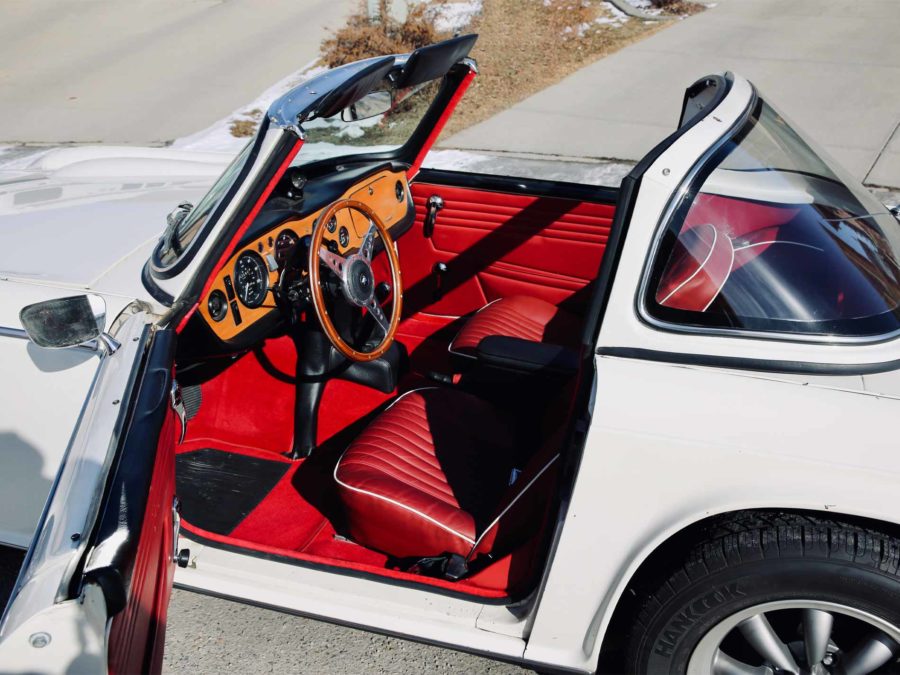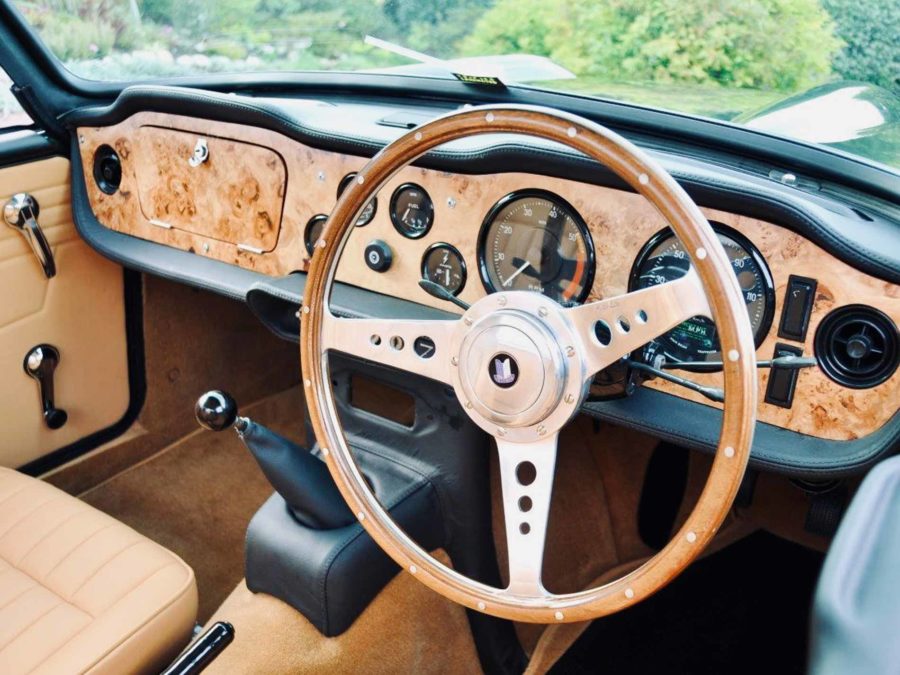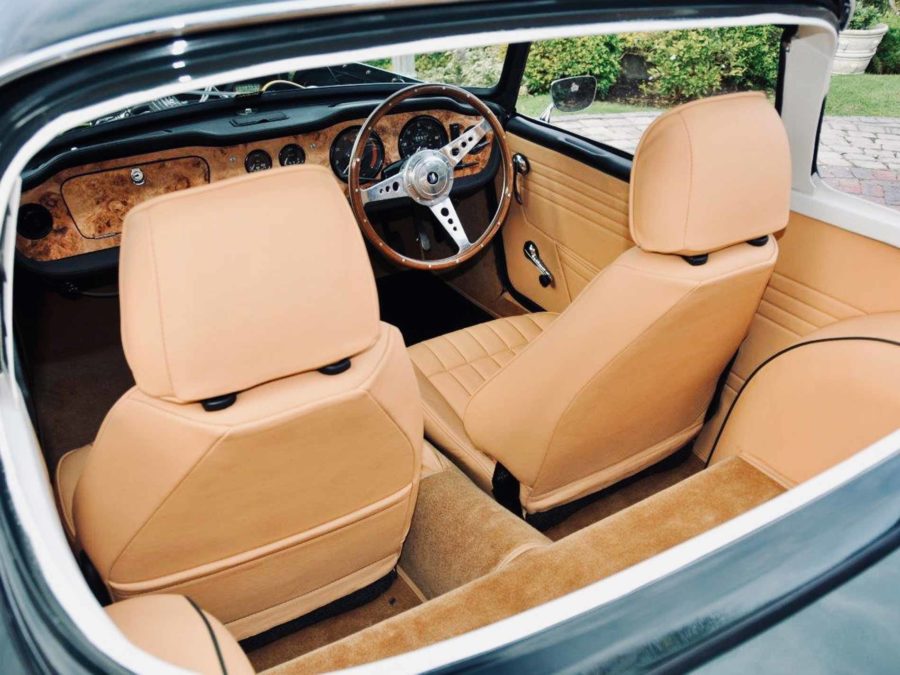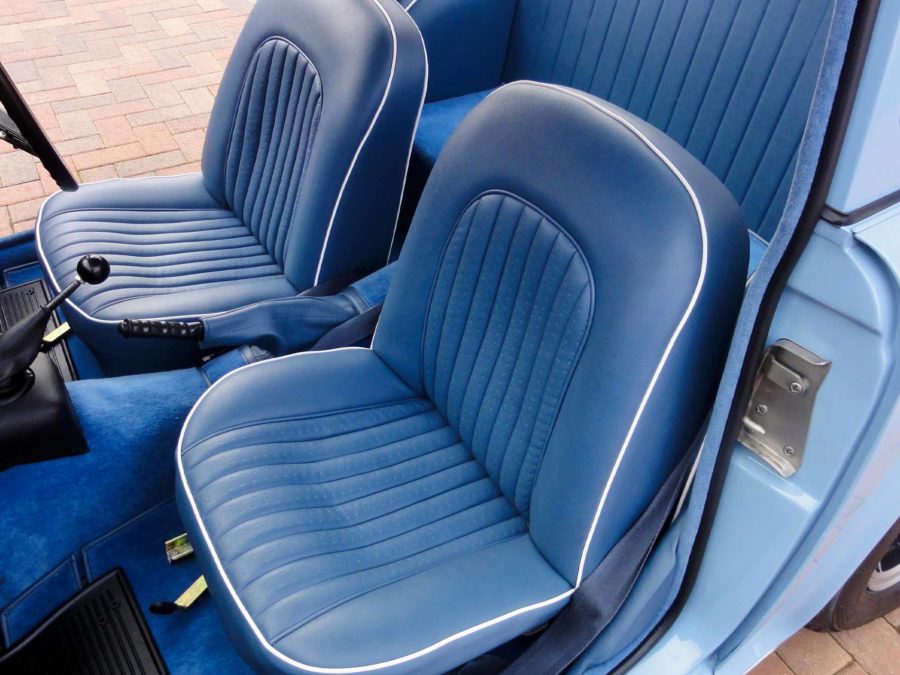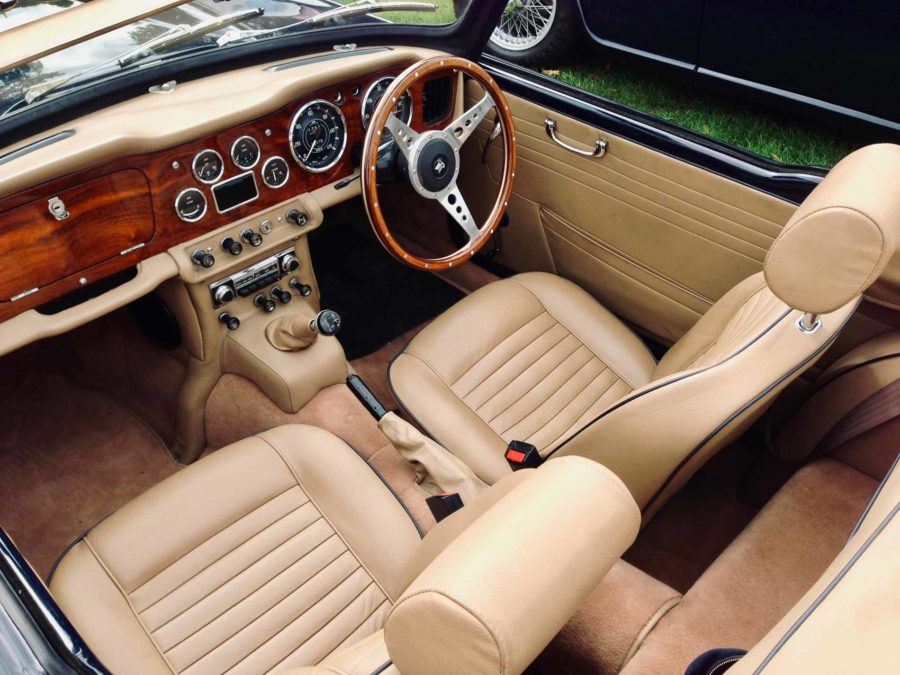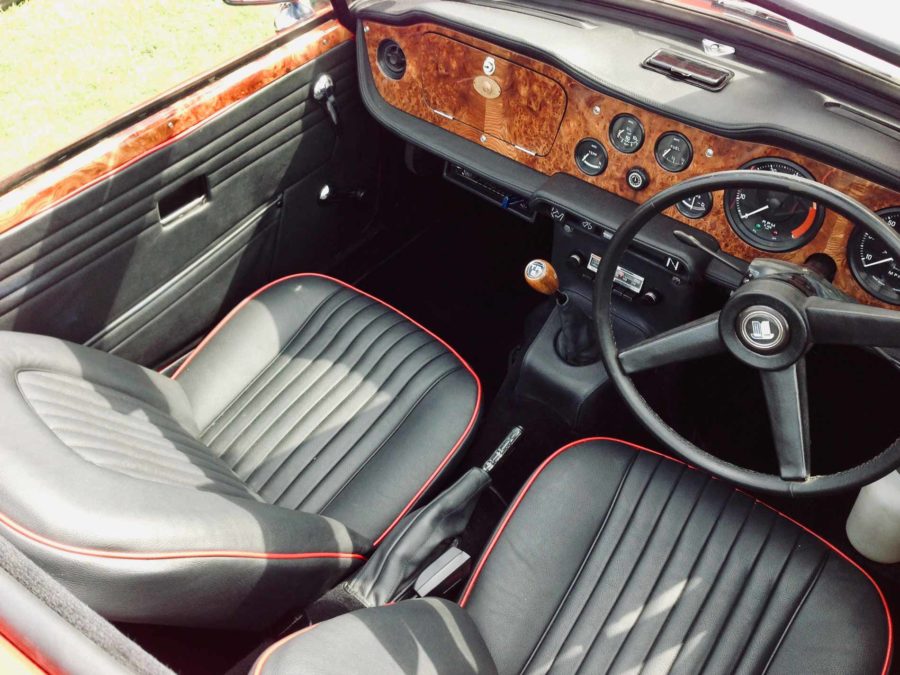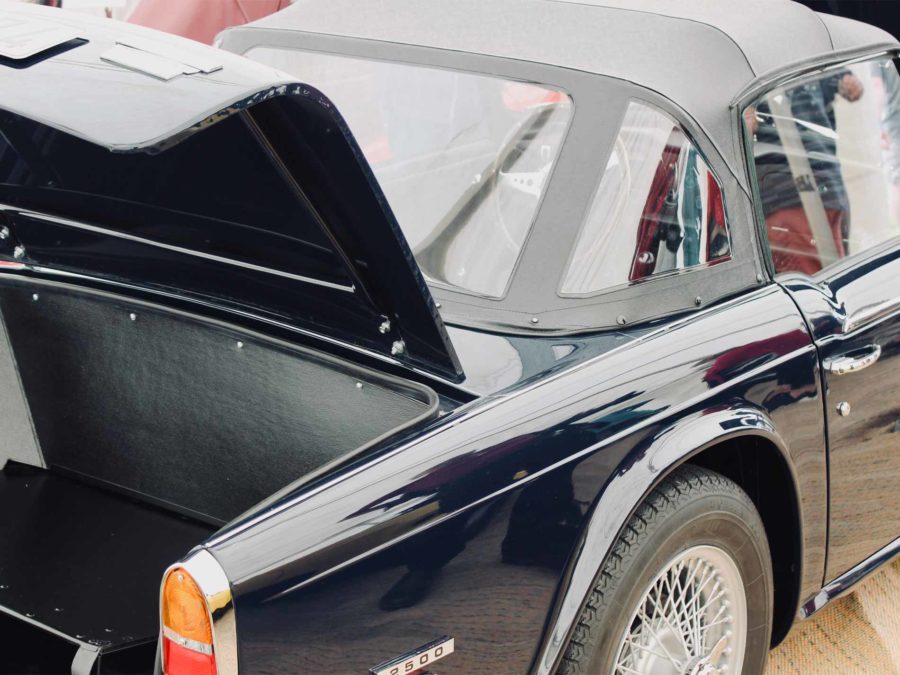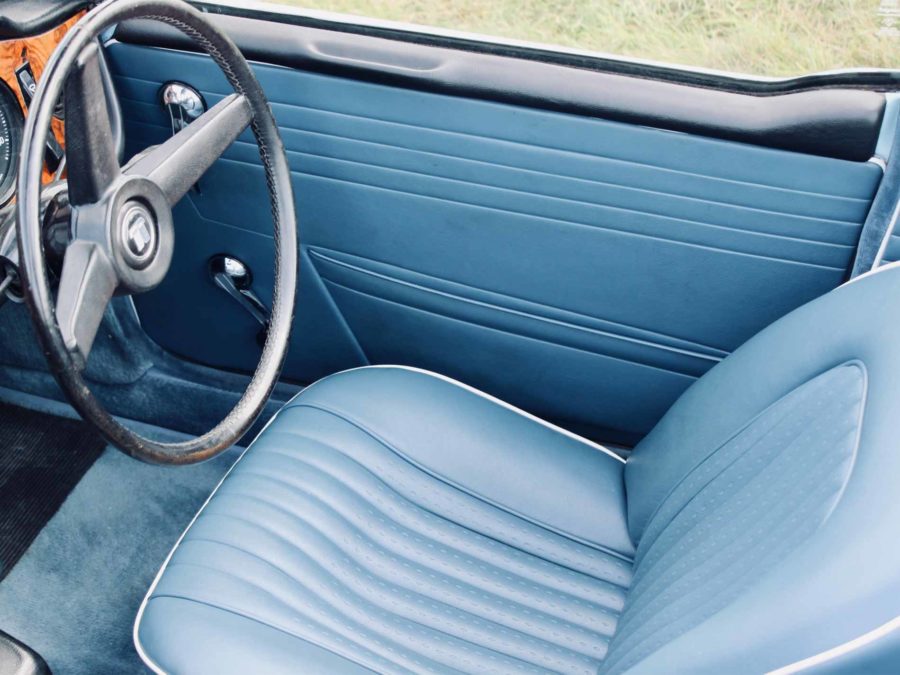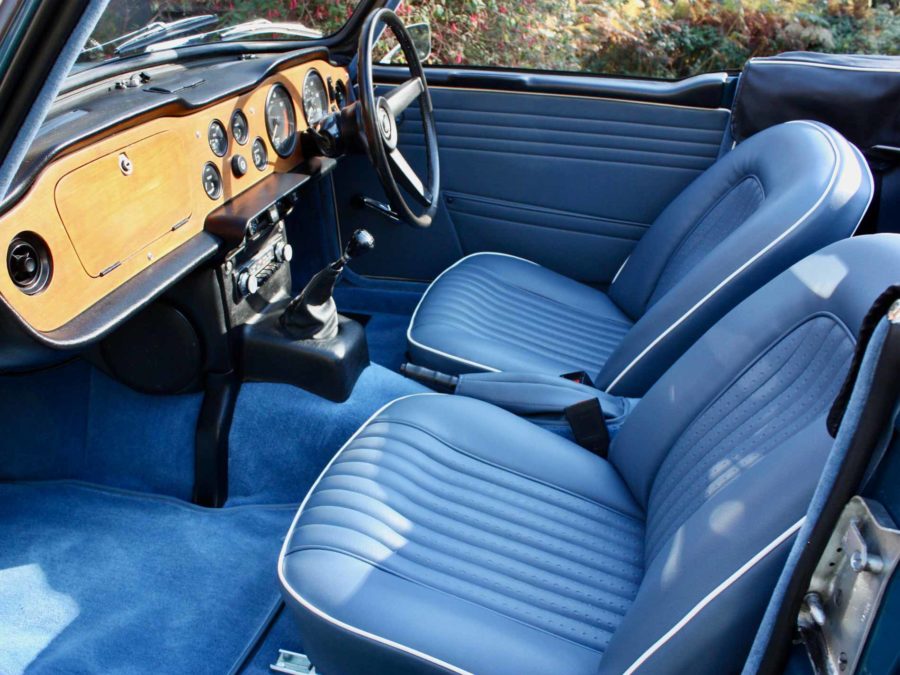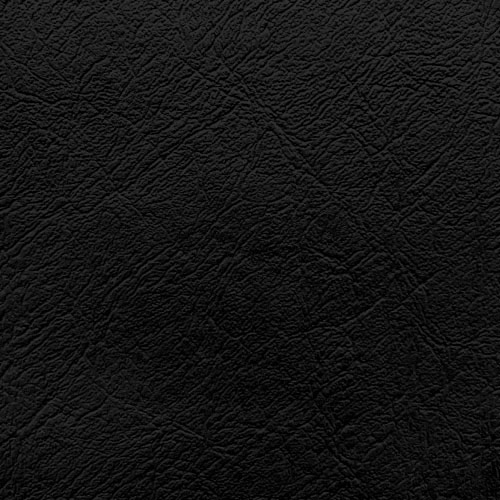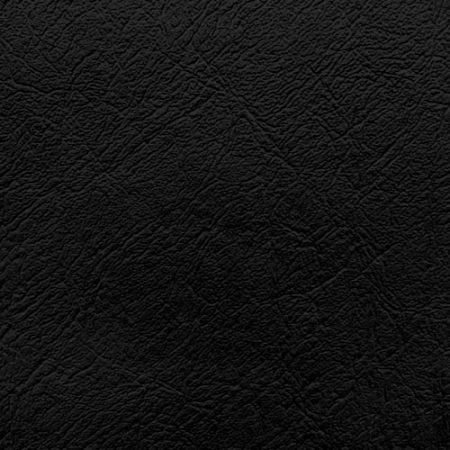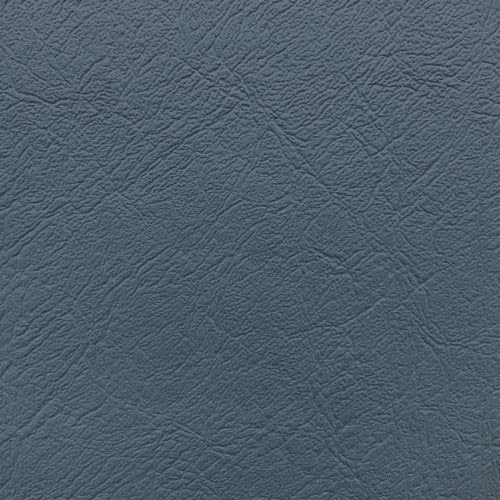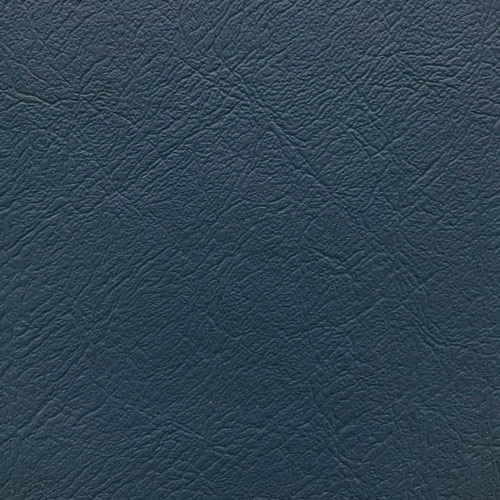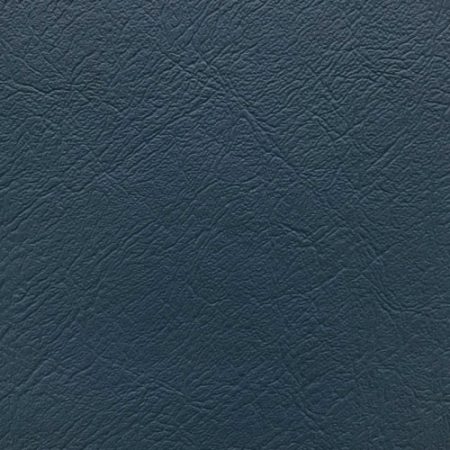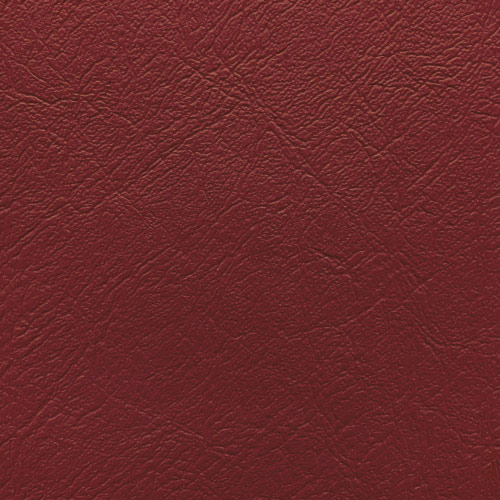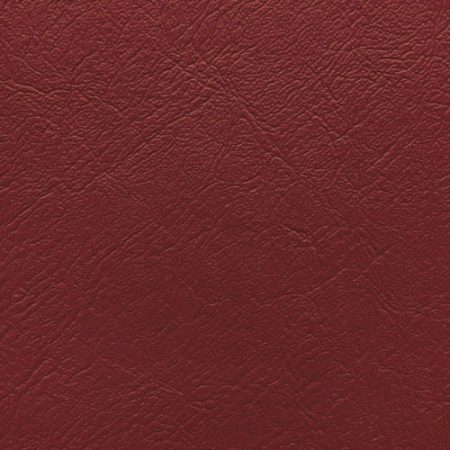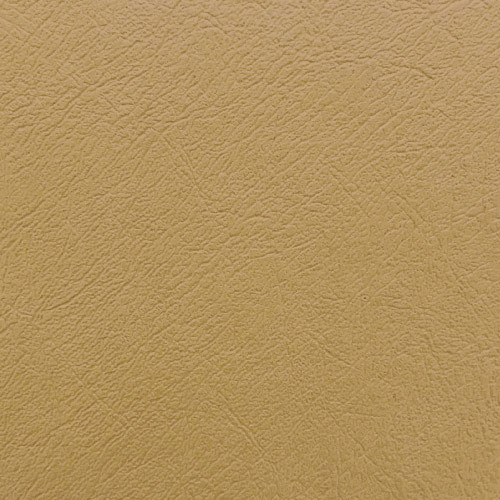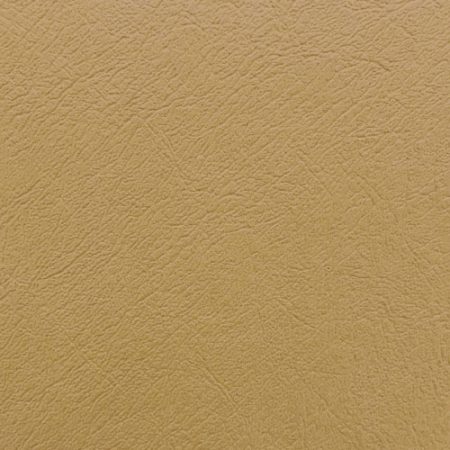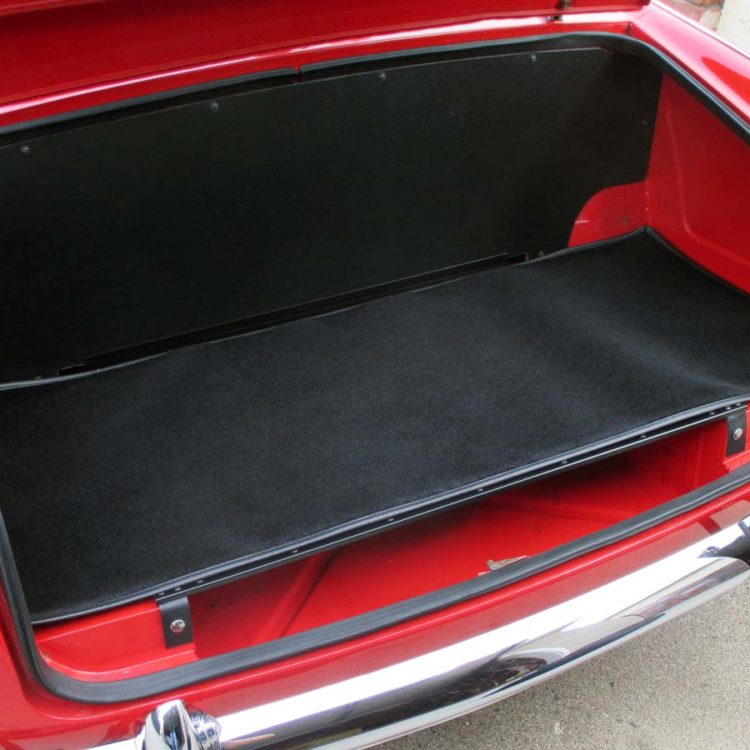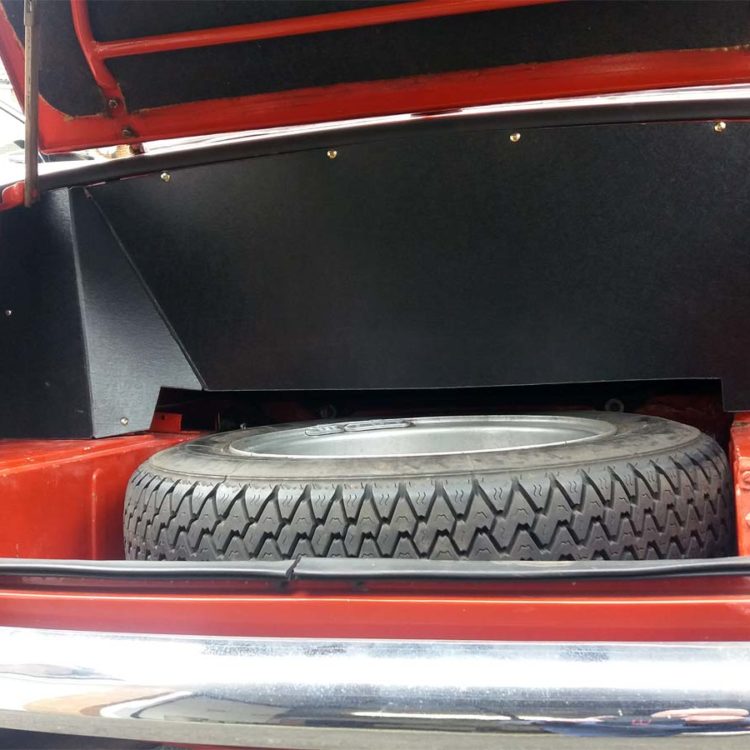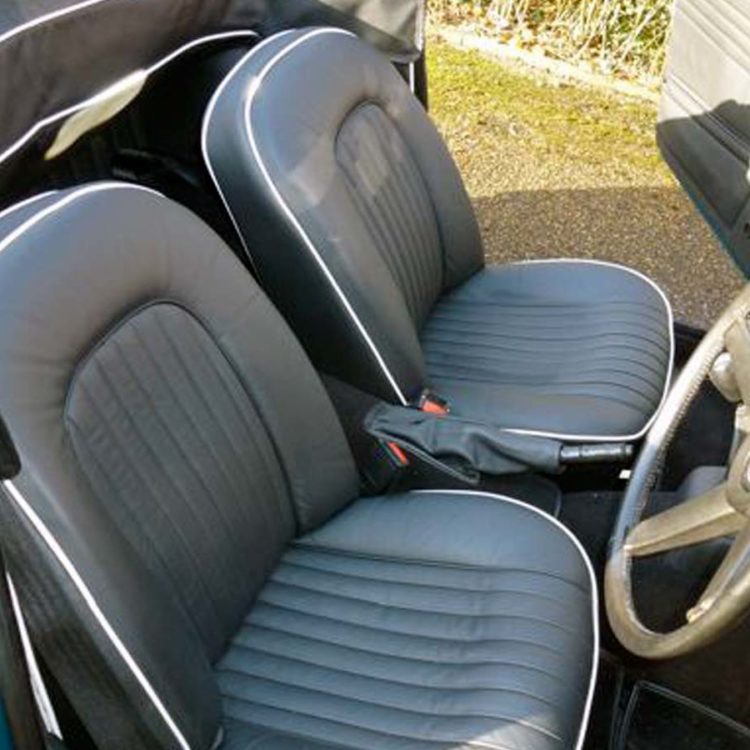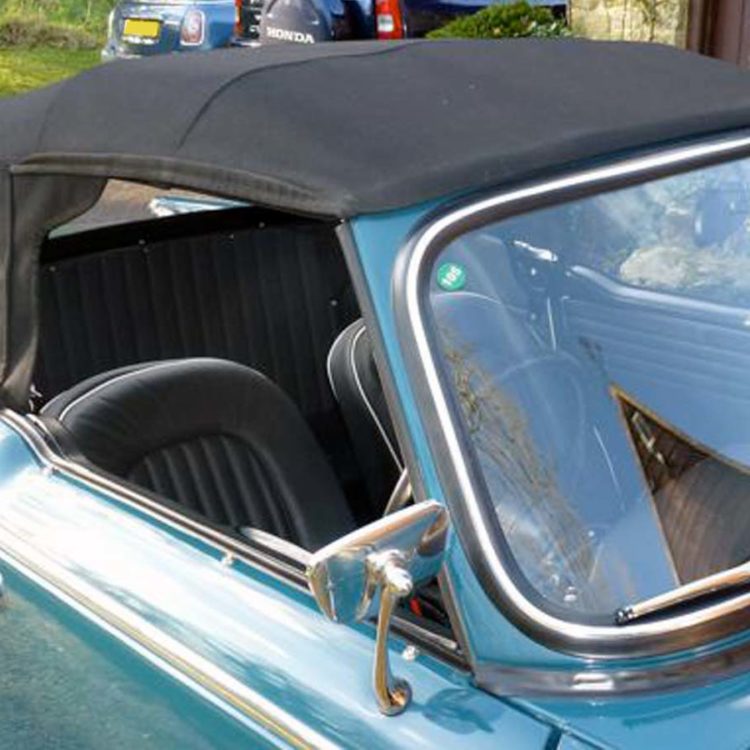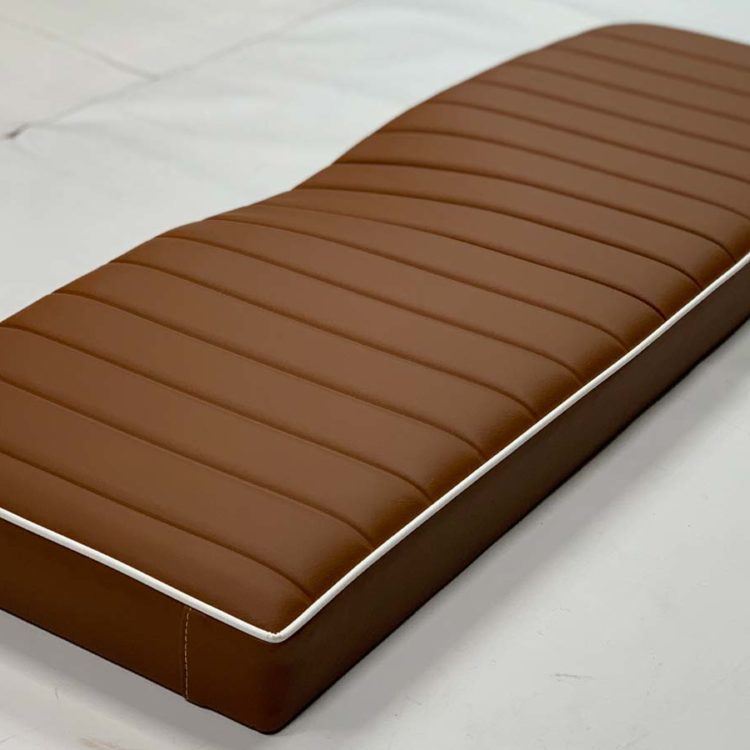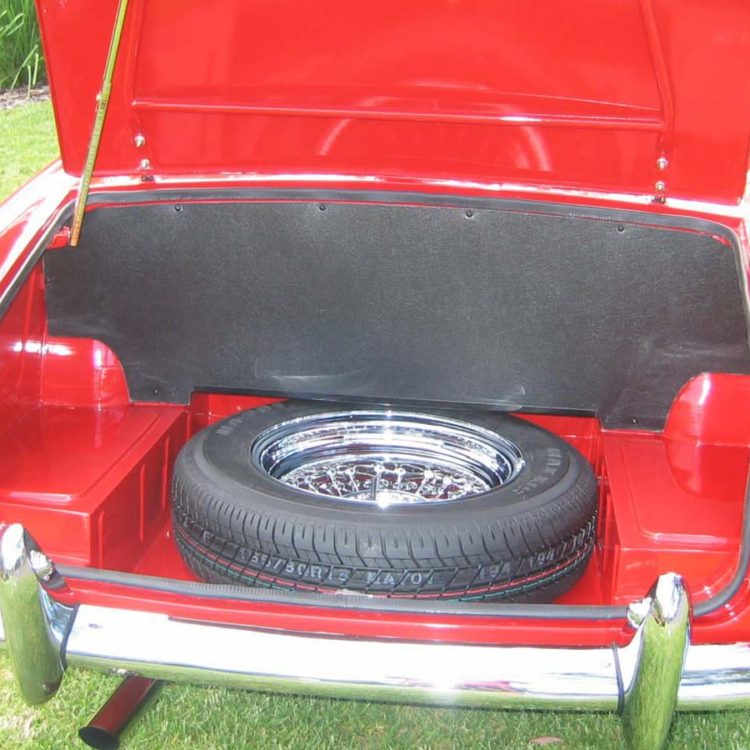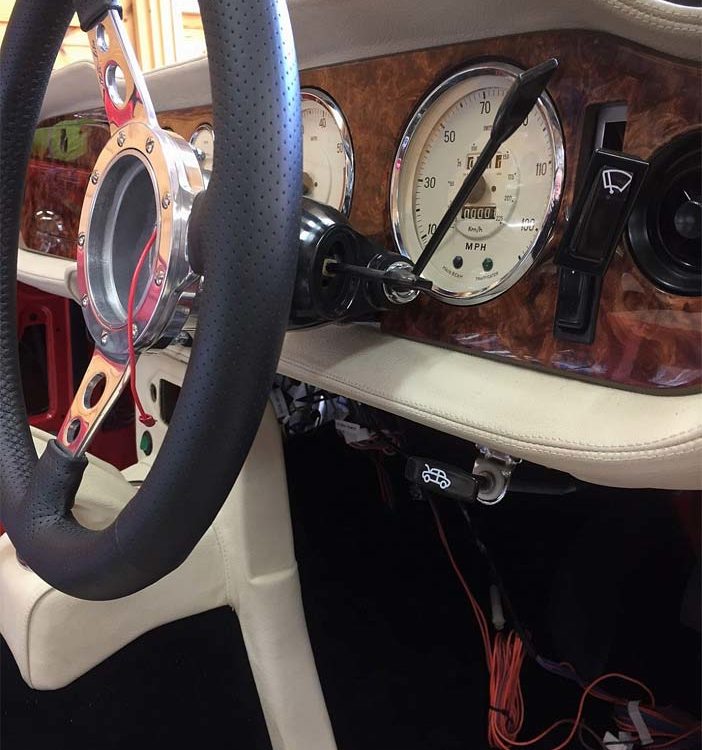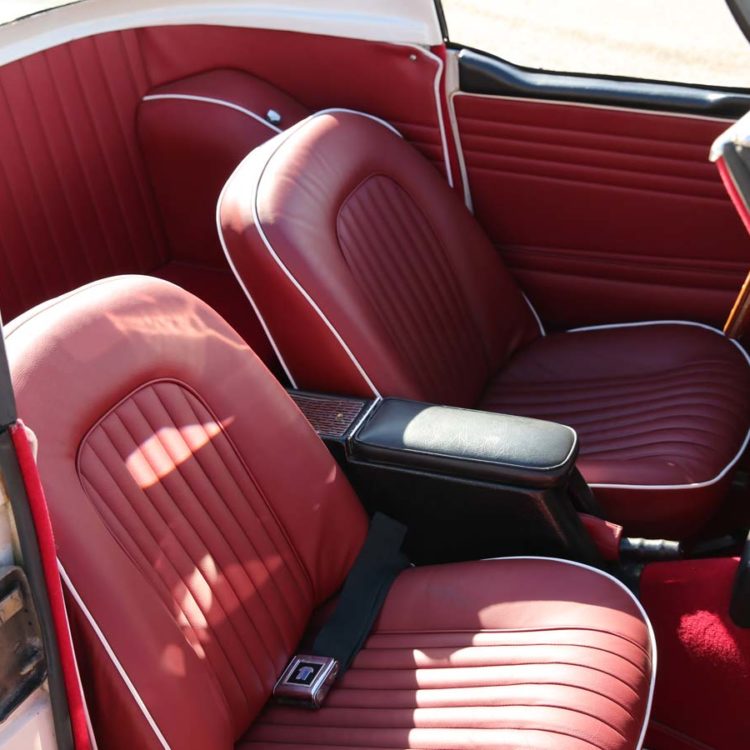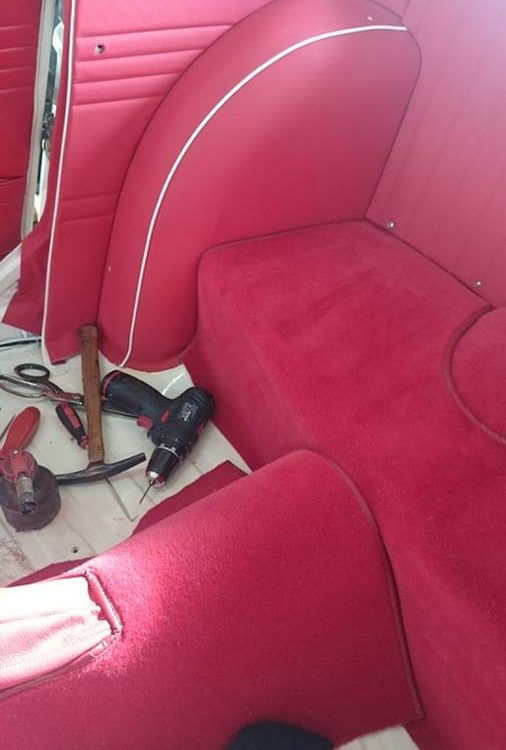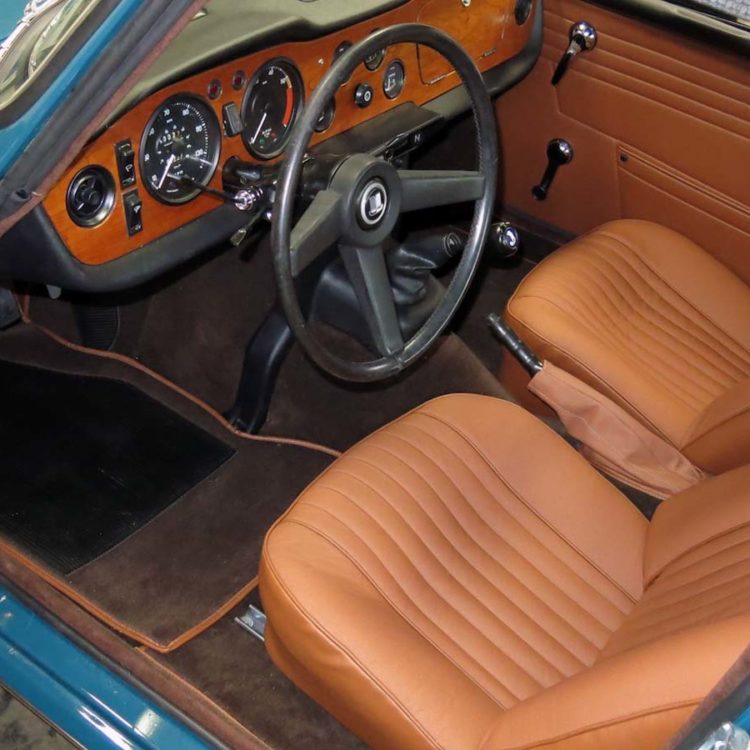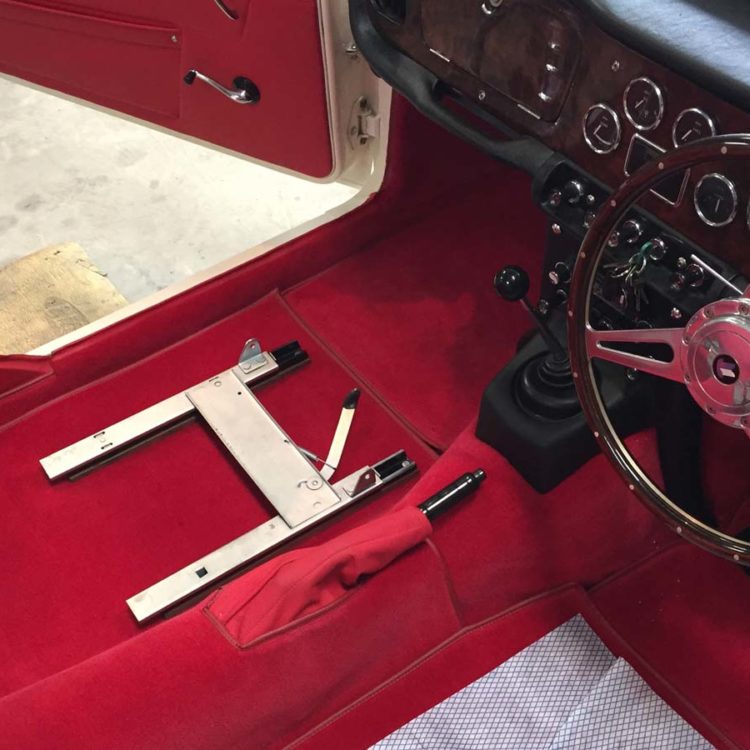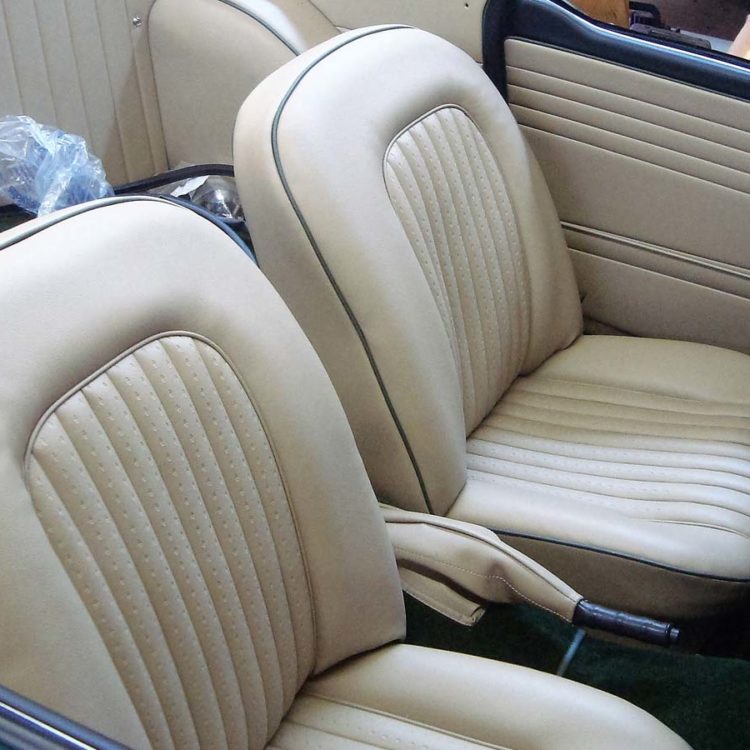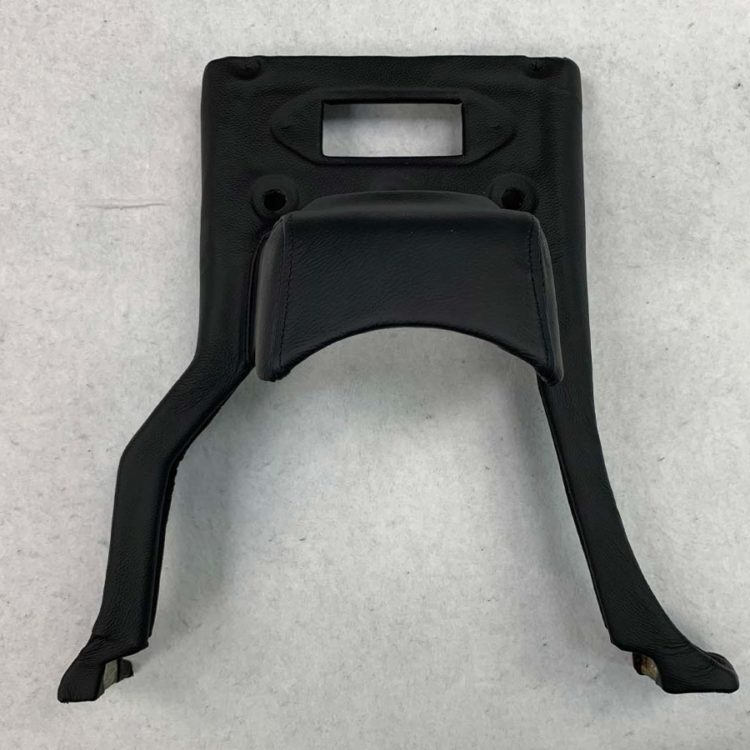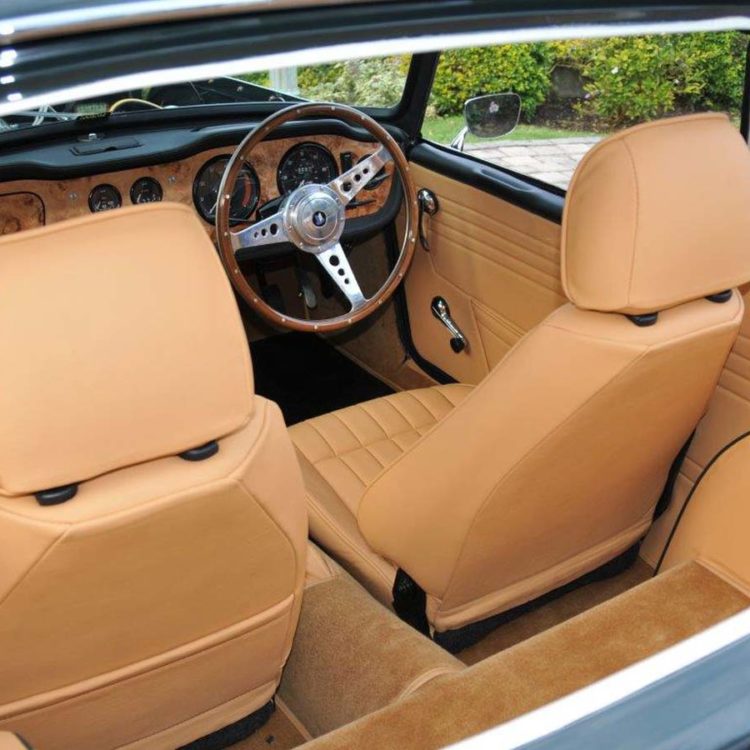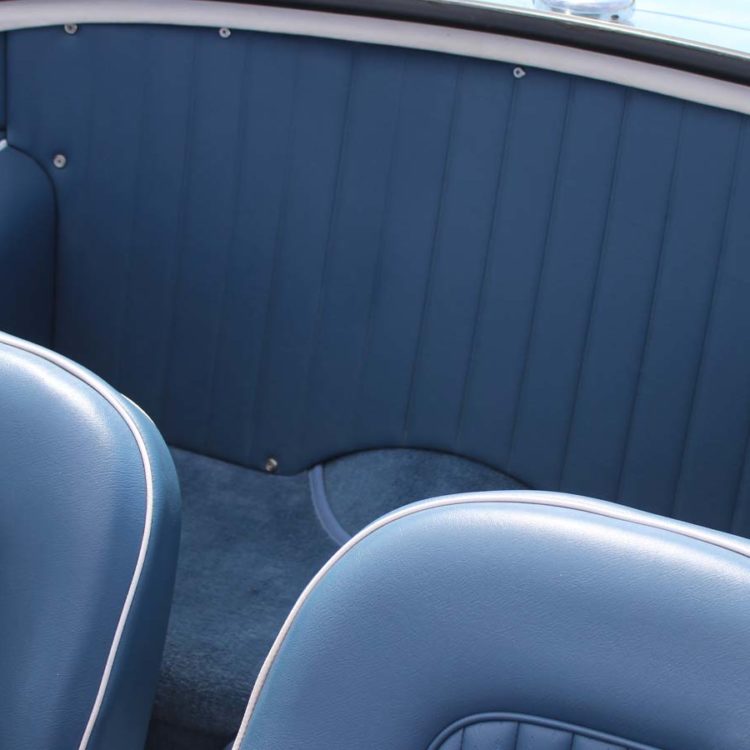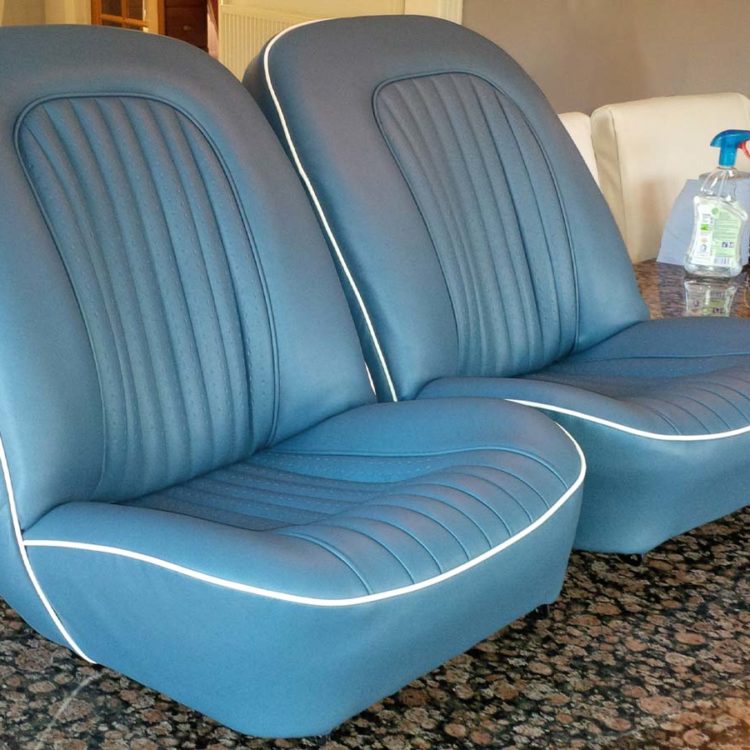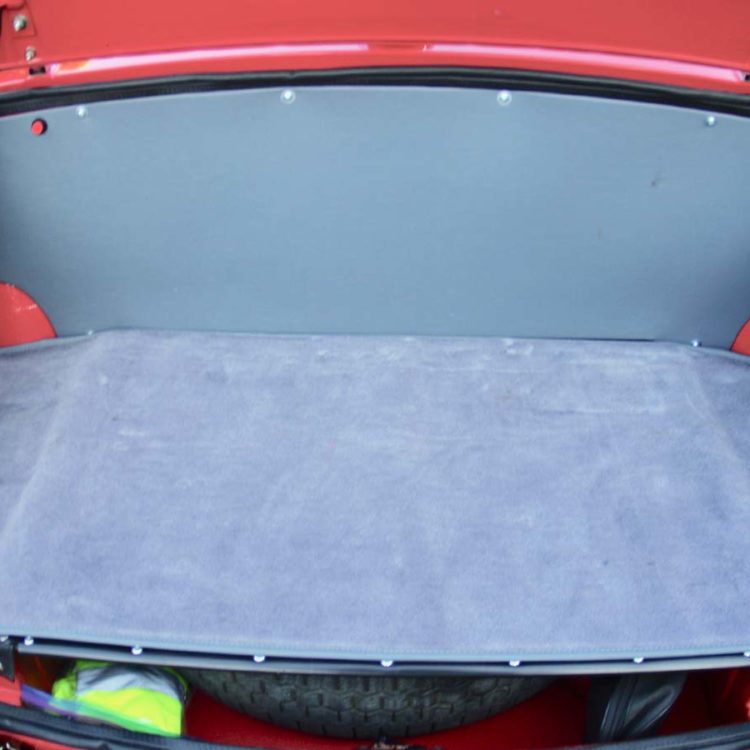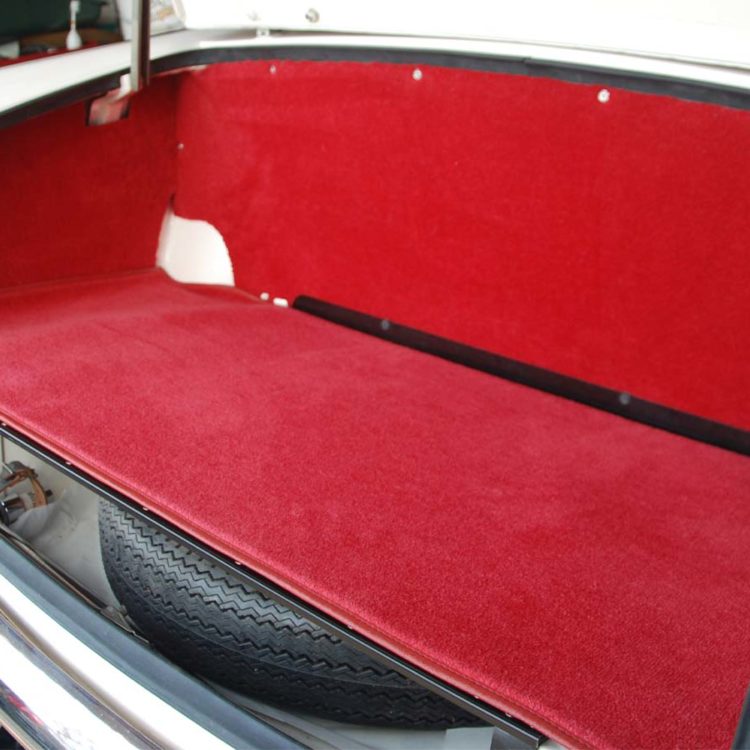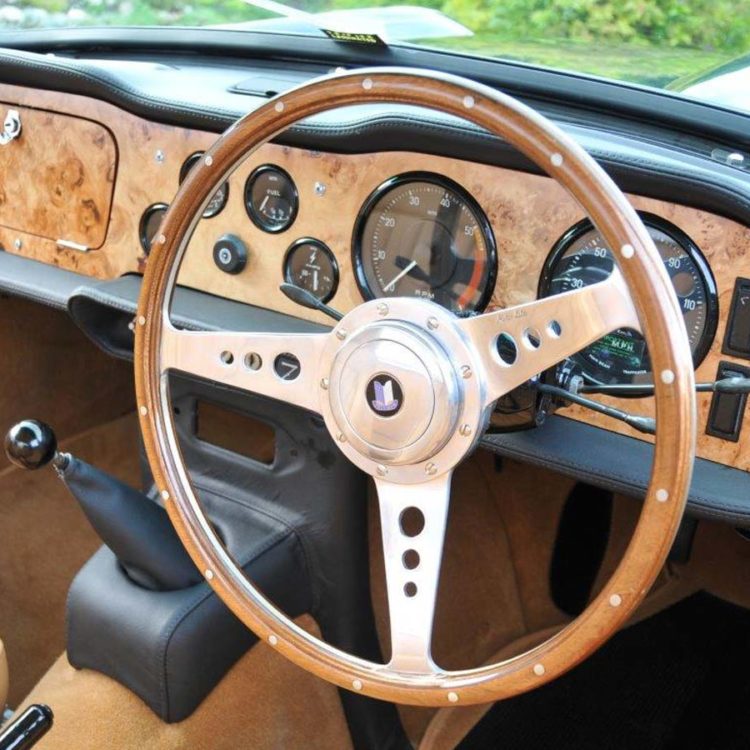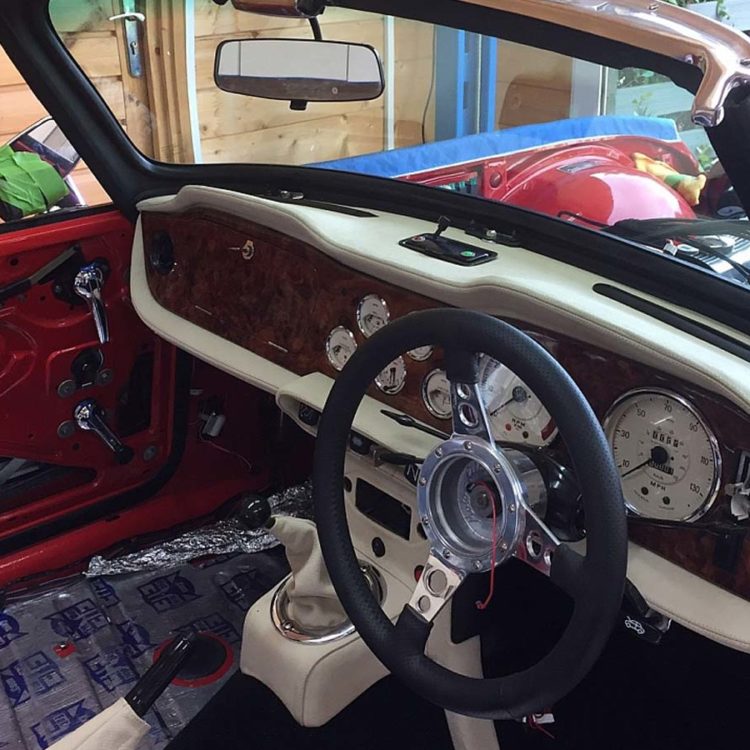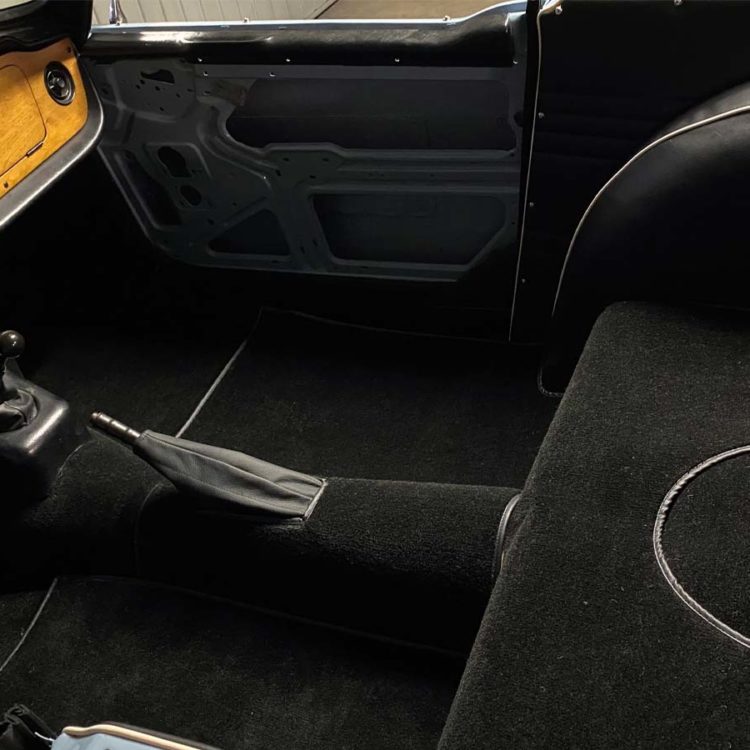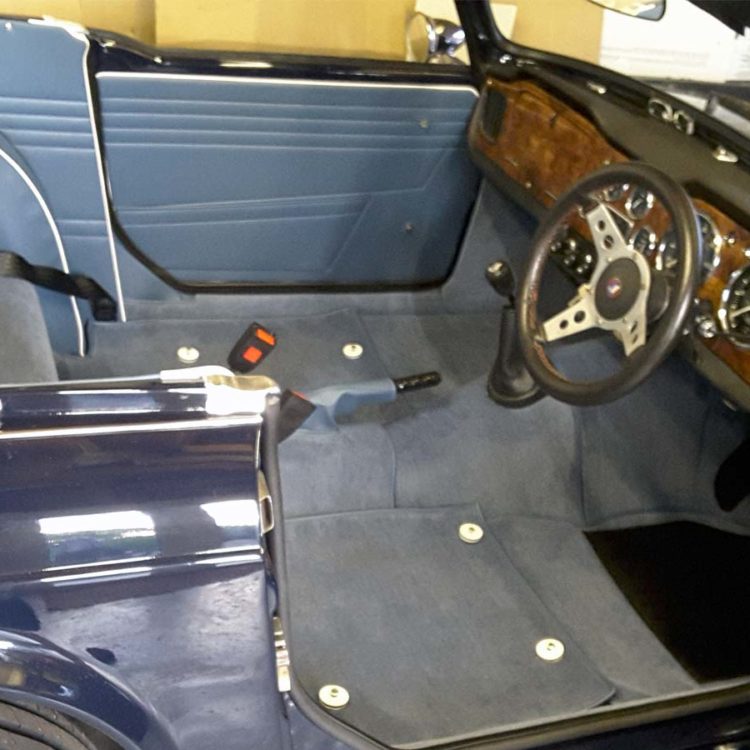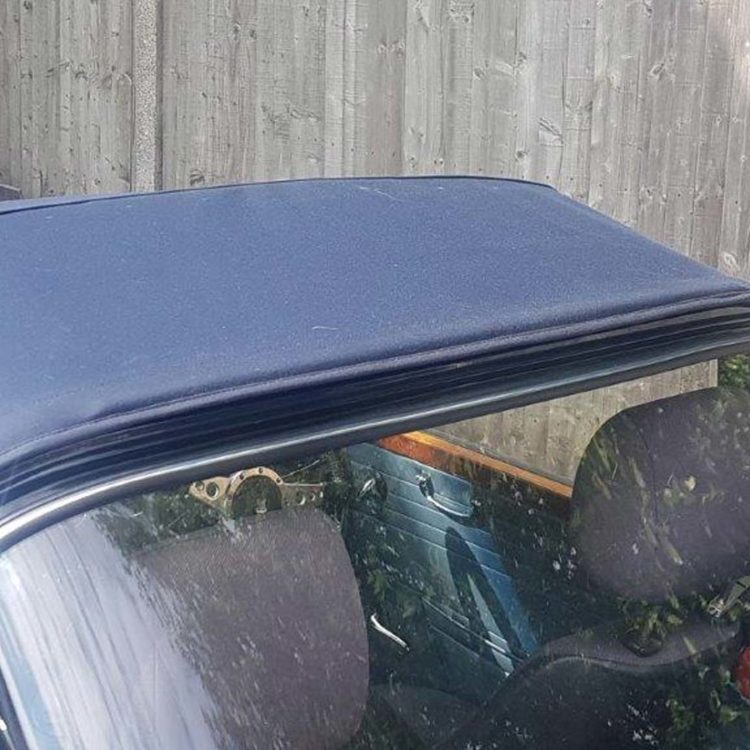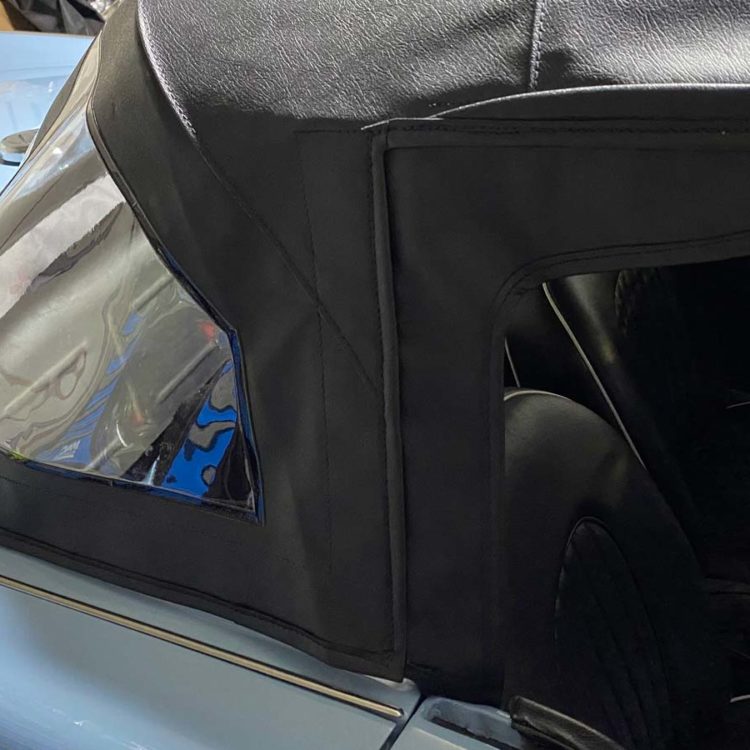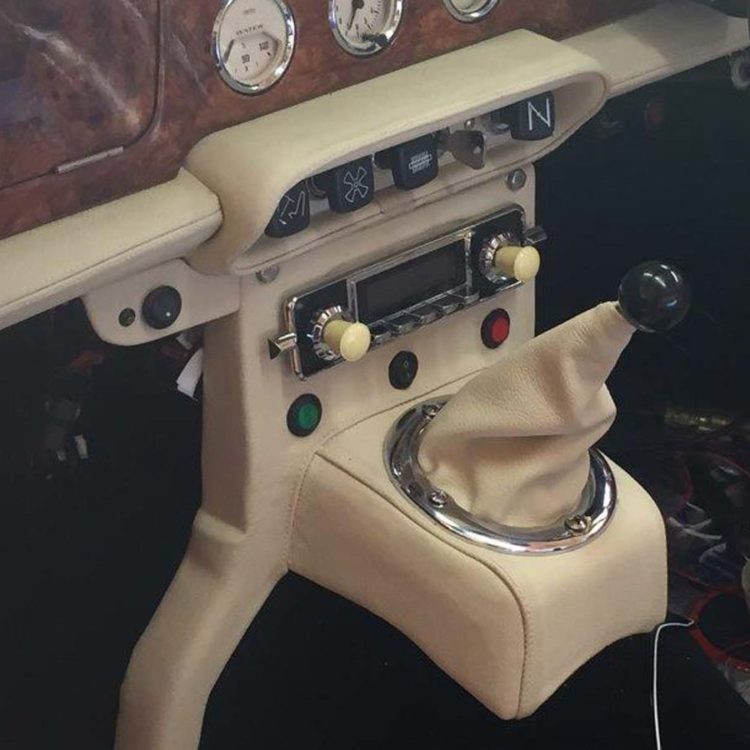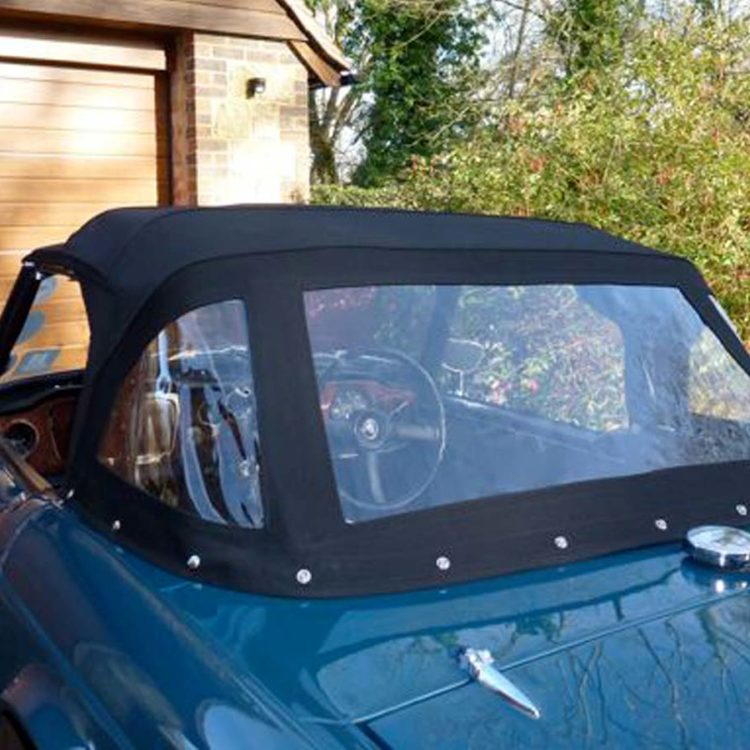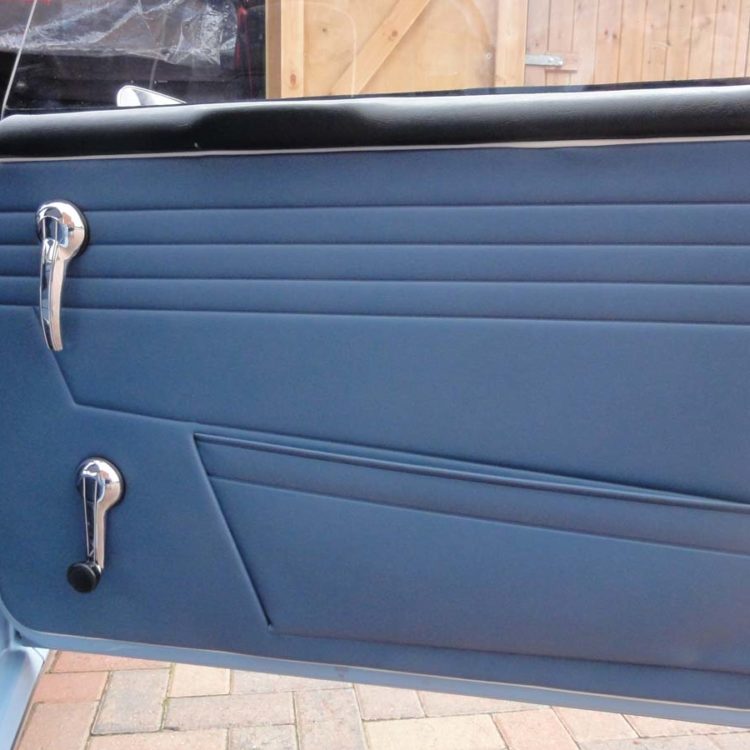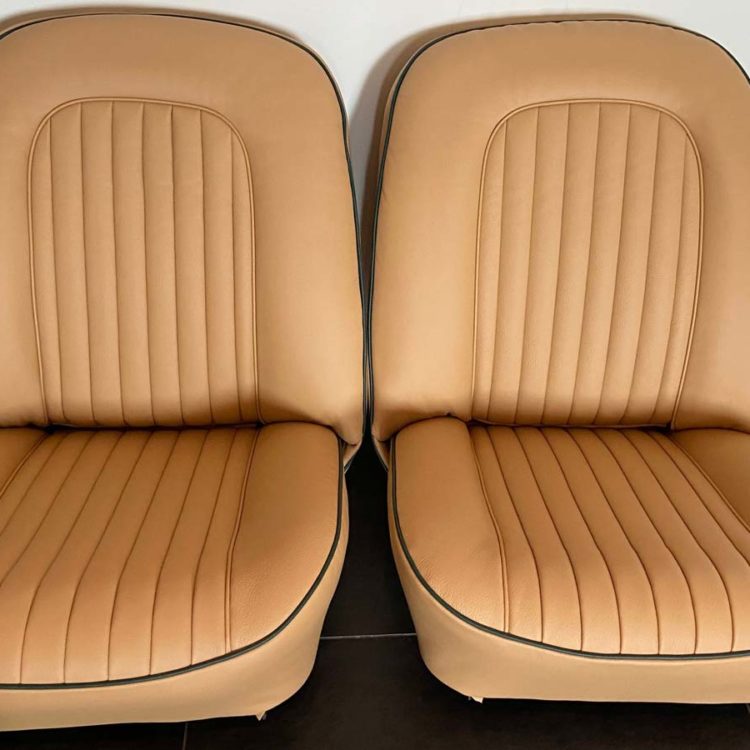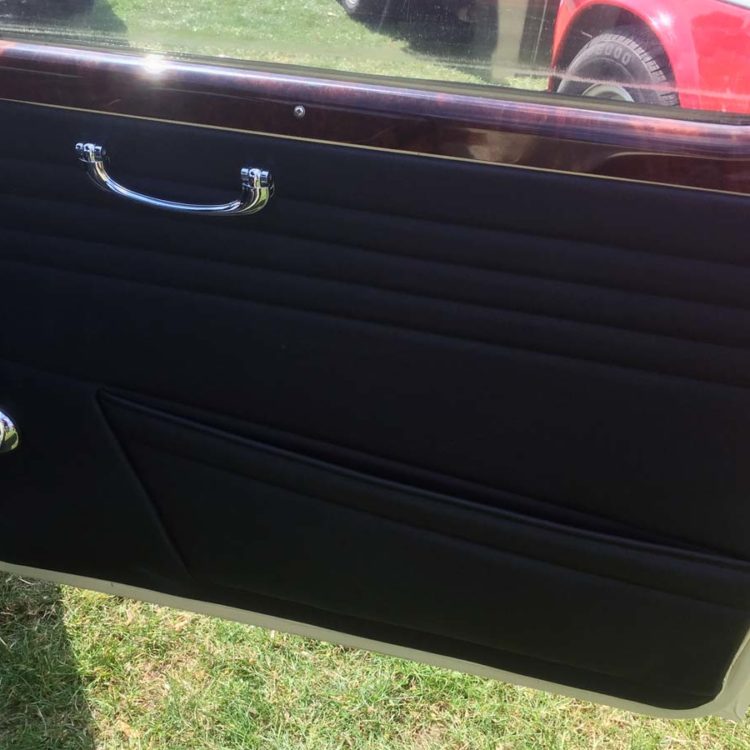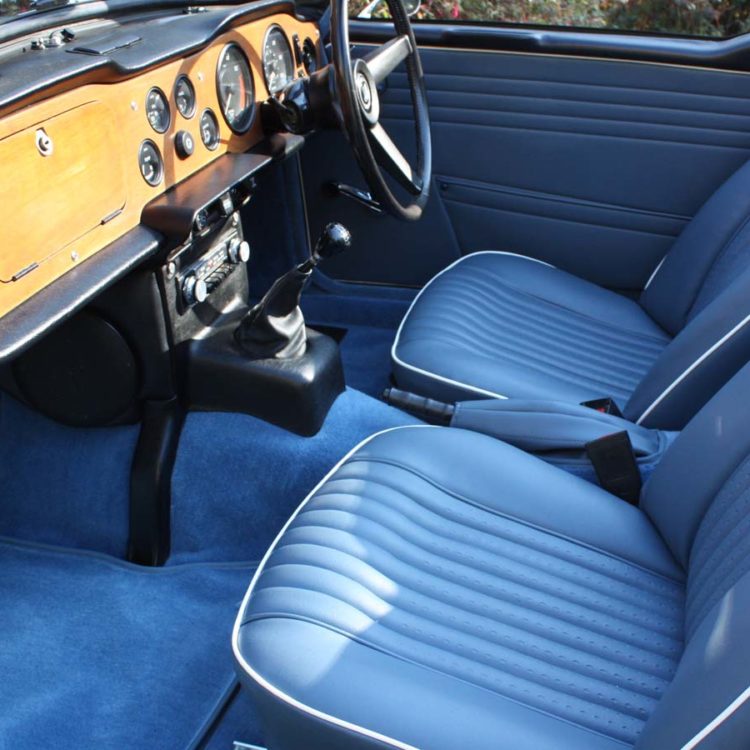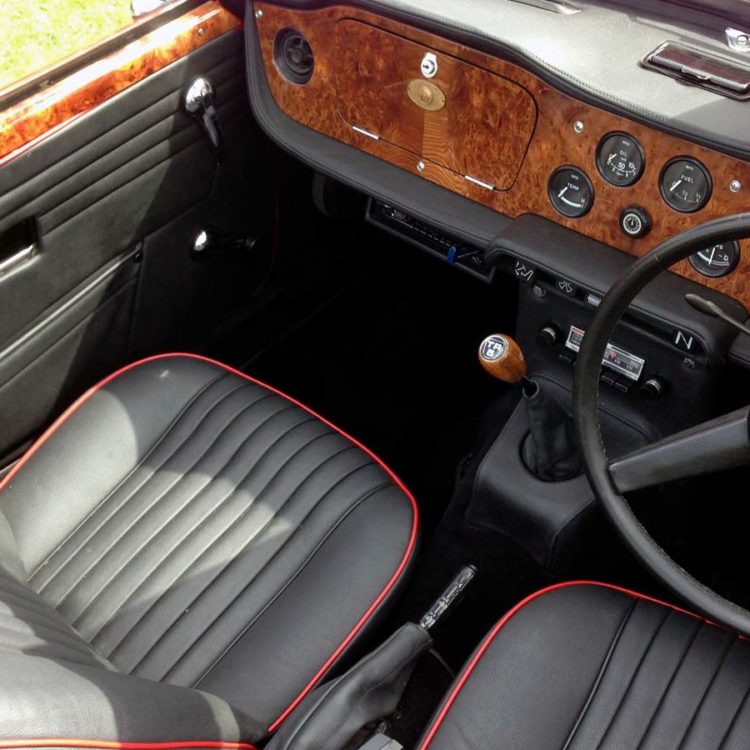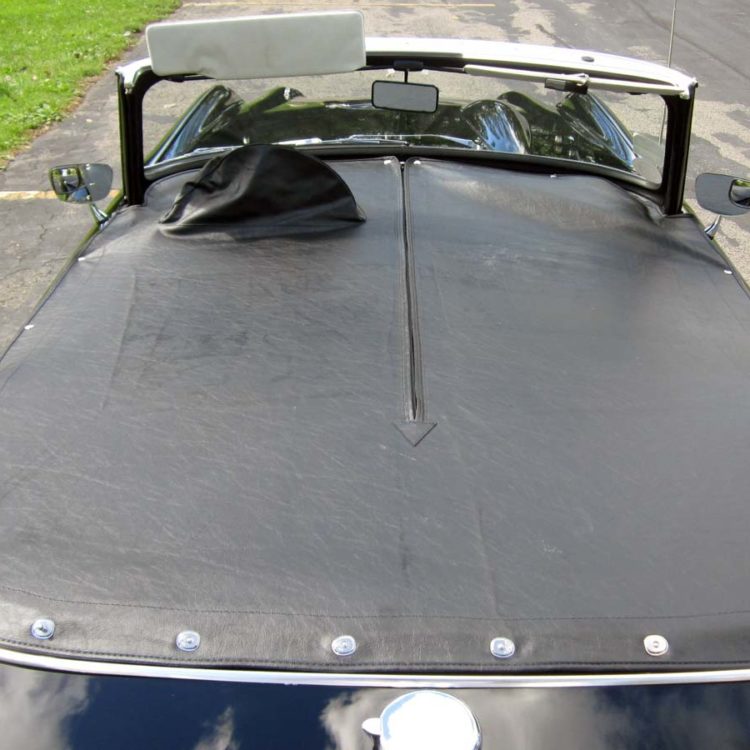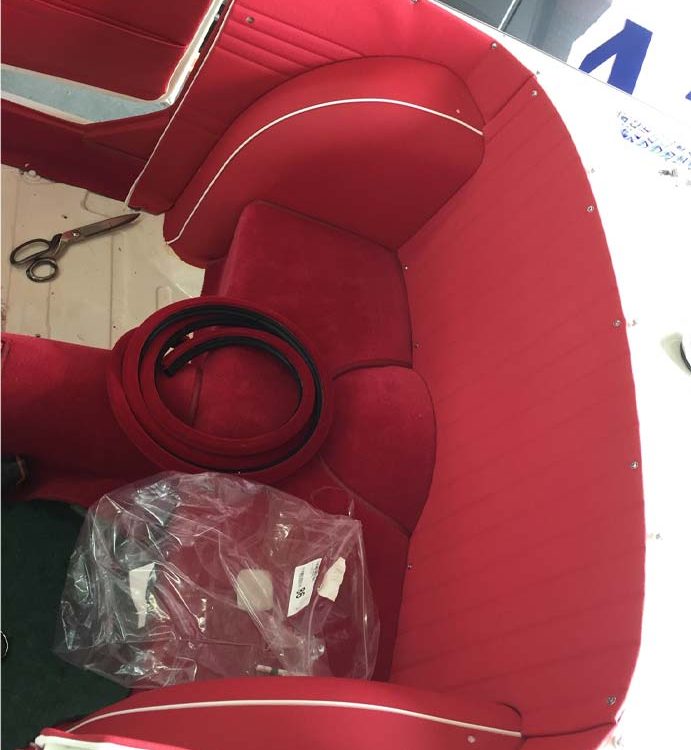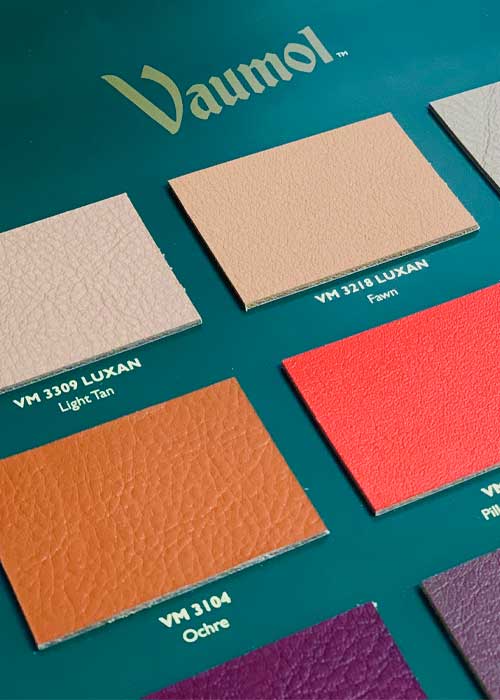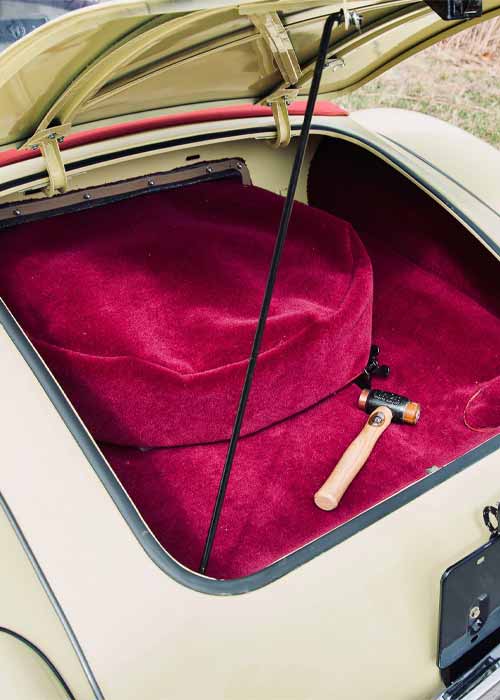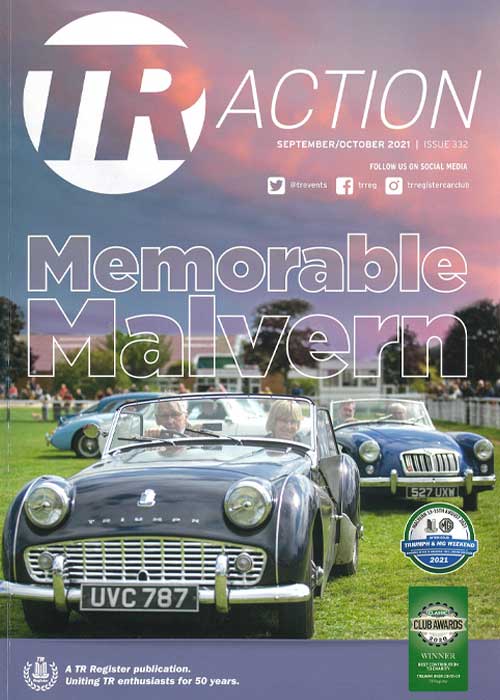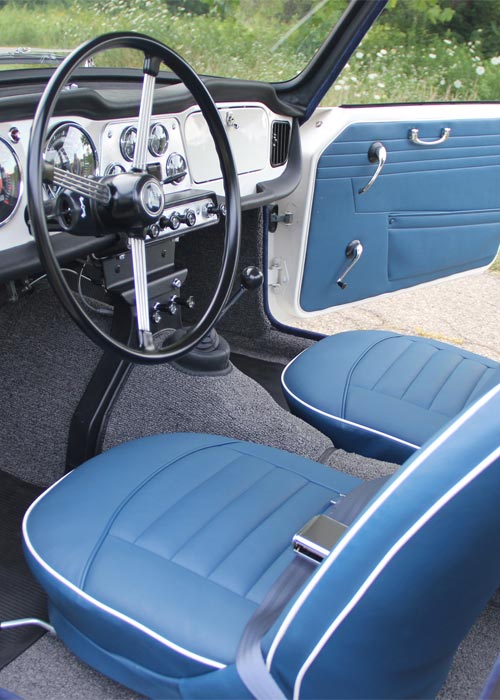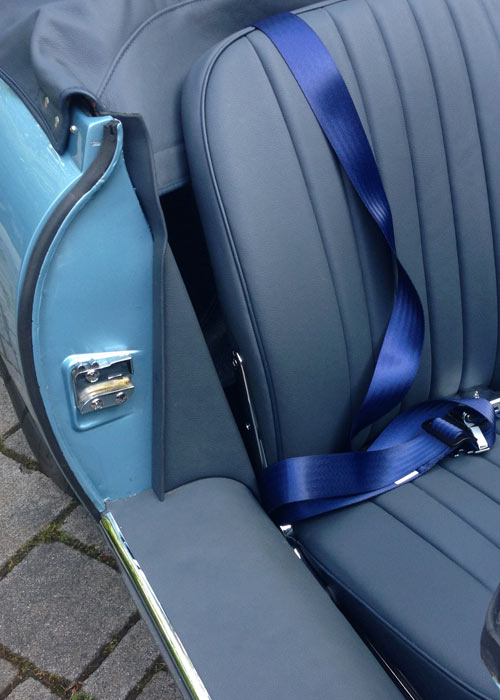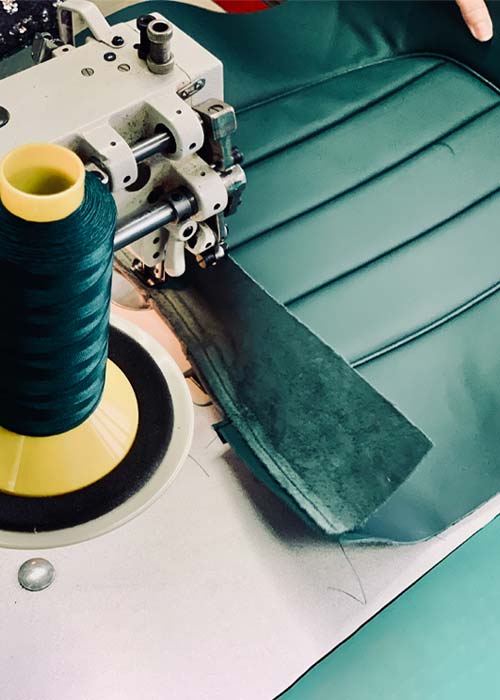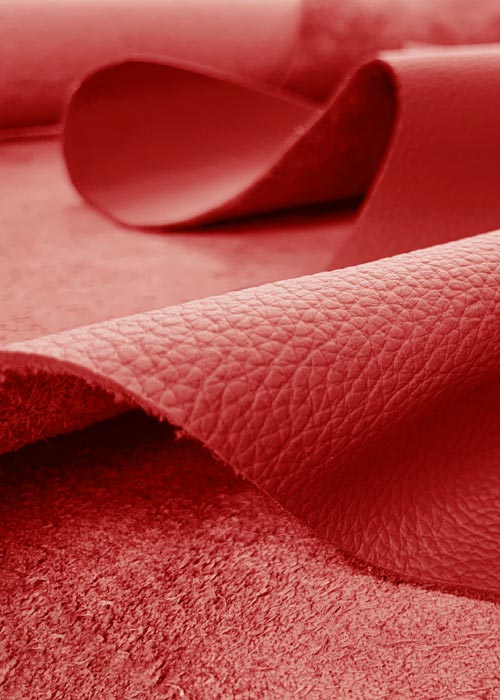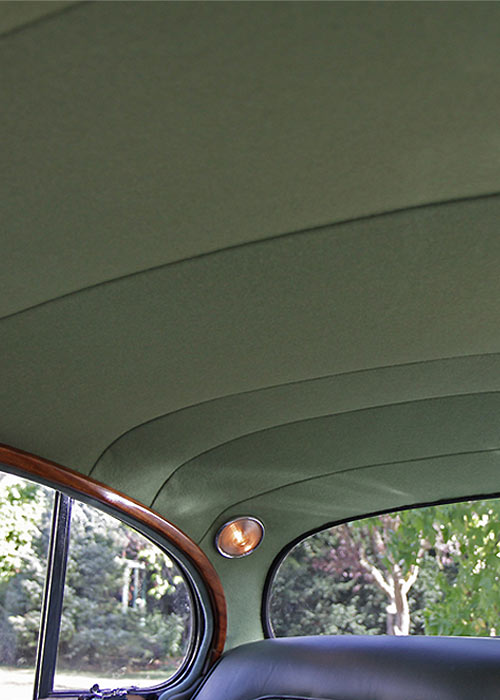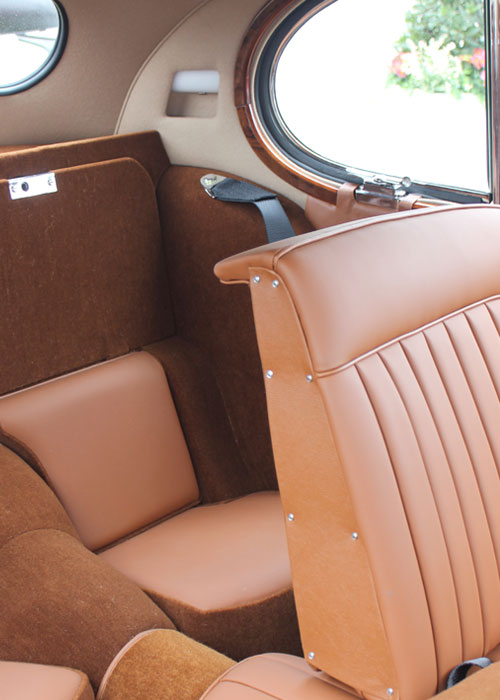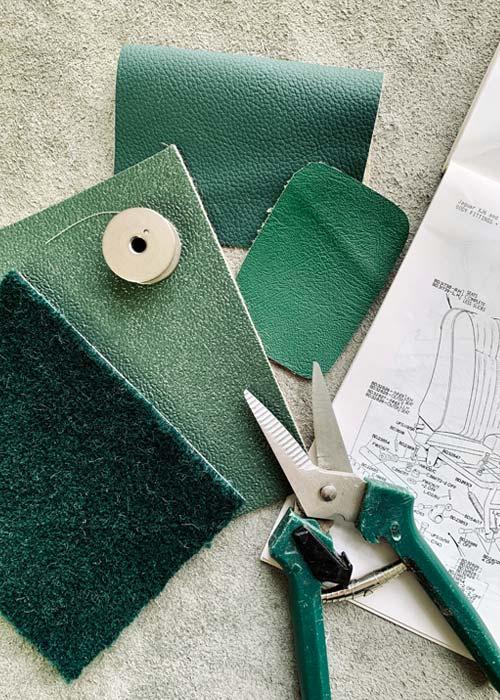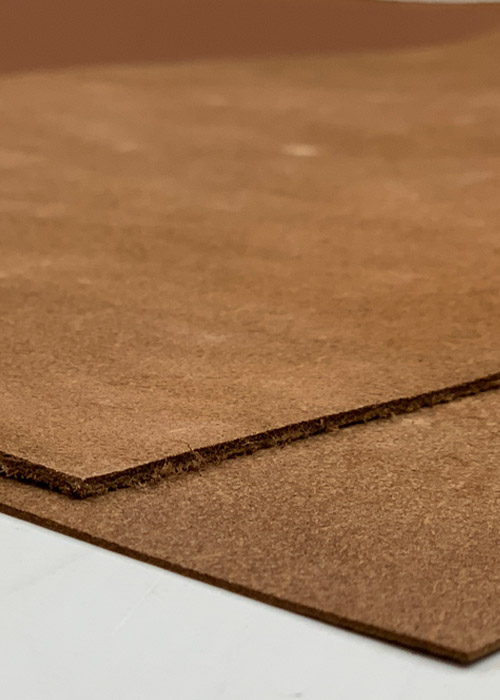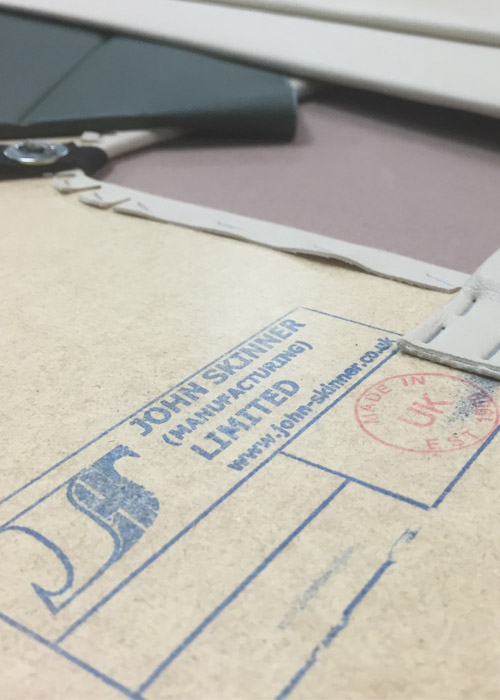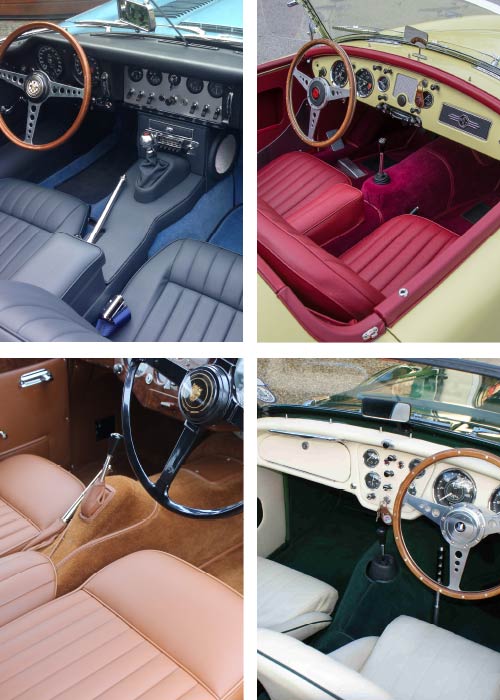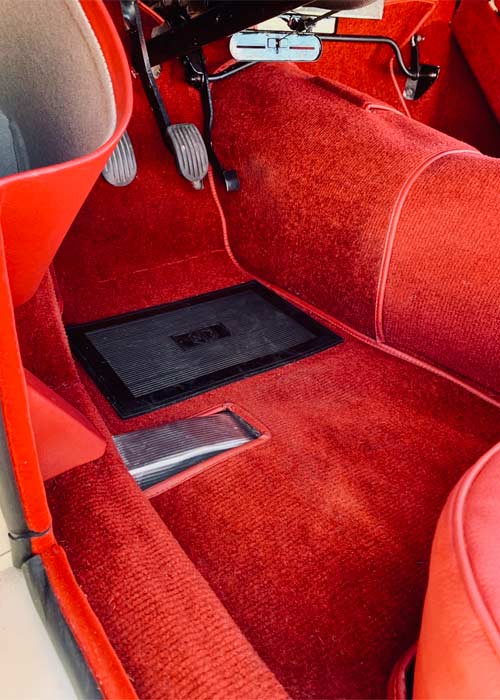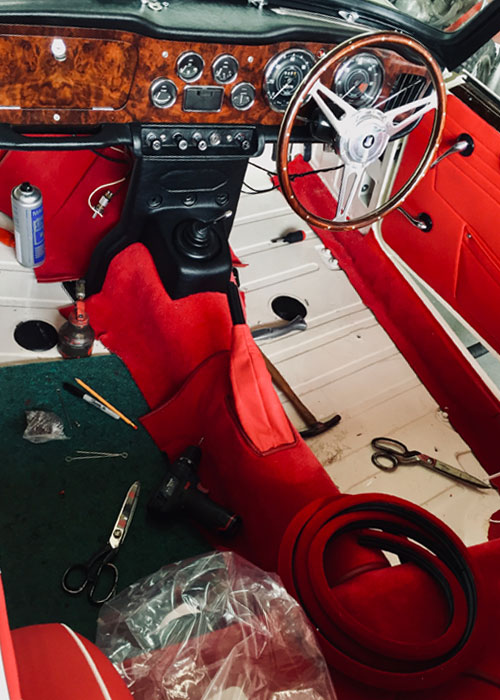
The Triumph TR5 P.I. is a Petrol Injection sports car produced by the Triumph Standard Motor Company. With a short production run of just 2,947 cars, manufactured between 1967 and 1968, the Triumph TR5 soon became a much sought after model. During the same period, the Standard Motors Company produced an American equivalent of the Triumph TR5 car – called the Triumph TR250 – which featured a Carburettor engine rather than Petrol Injection. In total, 8,484 TR250 cars were produced during 1967 and 1968.
John Skinner Ltd has produced awarding winning interior trim and upholstery kits for over four decades, including contributions to the Jabbeke MVC575 restoration, as well as the TS01 and TS02 cars – meaning that we have been involved in arguably three most important restorations of the TR era. In collaboration with Mark Macy of Macy’s Garage (USA) – we also provided the interior trim and upholstery for the perfect-100 score Triumph Register of America Concours award in 2018; the only car in the clubs’ history to attain this result. You can read more about this restoration here.
Start Your Restoration With Us
Use our Enquiry Form or send us an E-Mail to tell us about your restoration requirements.
To view our Parts & Prices – Download our Catalogues or visit our Build-a-Quote system.
A Restorer's Guide to the TR5 / TR250
We have created this OEM guide based on the knowledge we have acquired through well informed parts books and our own extensive records of original parts and photos, in addition to over 40 years experience in manufacturing trim restoration kits. However, we would always advise that due to inconsistent methods on the production lines and notoriously vague historical record keeping, that you take OEM specifications with the proverbial “pinch of salt.”
This guide gives a basic overview of how the cars would have originally left the factory, and may differ slightly to how we now manufacture the kits due to changes and advancements in modern day production methods and new – and more suitable – material developments. You can find detailed information on how we supply all our parts on the individual products pages within Build a Quote.
To help you best understand this guide, you may find our Glossary tabs useful where we list and explain common terminology used across interior trim.
Please note that there were production inconsistencies during this period, so colours should be chosen on individual basis.
| PAINT COLOUR | INTERIOR TRIM COLOUR OPTIONS | SOFT TOP OPTIONS |
|---|---|---|
| Black | Black, Red (“Matador Red”) | TBC |
| New White | Black, Red (“Matador Red”), Tan (Light Tan), Blue (“Shadow Blue”) | TBC |
| Royal Blue | Black, Blue (“Shadow Blue”) | White, Black |
| Jasmine Yellow | Black | TBC |
| Signal Red | Black | White, Black |
| Valencia Blue | Black, Biscuit Light Tan | TBC |
| Triumph Racing Green | Black, Biscuit Light Tan | TBC |
Information from:
Piggott, B. (1991) Original Triumph TR – The Restorer’s Guide to TR2, TR3, TR3a, TR4, TR4A, TR5, TR250, TR6, Bideford: Bay View Books Ltd.
The September 1967 Colour and Trim Brochure for Triumph TR5 / TR250 (Roger Ferris, TR Register, 2022).
Triumph TR5 / TR250 Original Colours supplied by John Skinner Ltd
It is widely accepted that the interpretation of original shades varies depending on who you ask – and may well have varied from the original factory production line. As a result, John Skinner Ltd offers multiple shade options for each original colour.
Colour names refer to internal John Skinner Ltd colour names, not necessarily the names Triumph originally used for these colours.
We can also offer non-original custom colour schemes if you so desire. Please see our online shop for more details.
As part of the quotation/ordering process, we will arrange for samples to be sent for final confirmation – so browse and shop with complete peace of mind, knowing that we will guide you through step-by-step with all the information you require.
A note on Piping/Beading

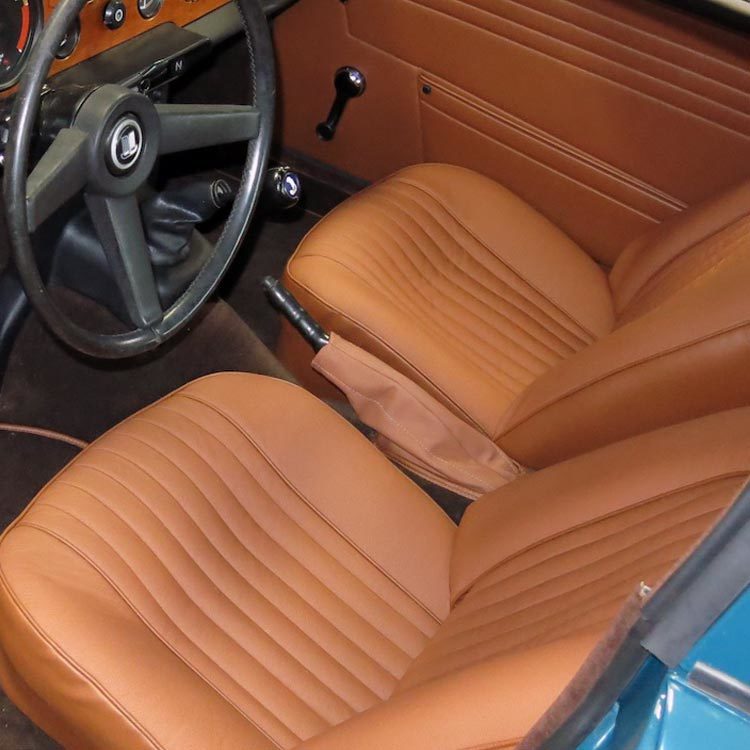
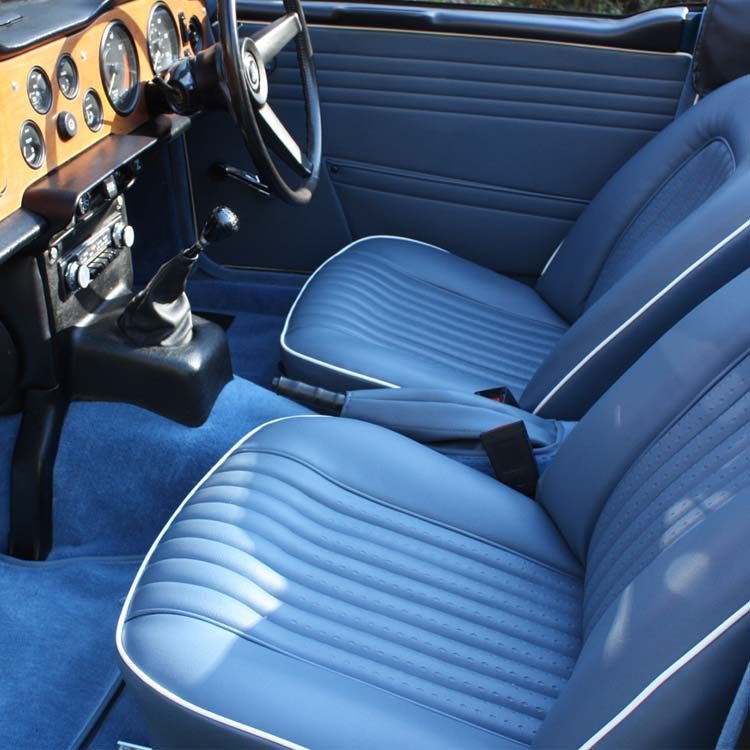
Triumph TR5 / TR250 models originally featured White Piping on the majority of cars that left the factory production line, with a few recorded instances of Piping matching the main trim colour.
We can also offer the largest range of non-standard “bespoke” colours schemes for those looking for a more customised finish.
Interior Trim Panels
The interior trim panels of the TR5 and TR250 remained largely similar to what was seen on the TR4A, with the most significant changes appearing around the Dash and Console areas. The Passenger side Grab Handle was removed and the Switch Plinth assembly was revised – both of which remained this way until the end of the TR6 production run. It is worth noting that the positions of the Window Winders and Door Releases changed for the TR5/TR250 models – versus that of the earlier TR4/4A models – and all John Skinner blanks accommodate for these changes.
Panels
The interior trim panels consisted of the main Door Panel Casings (and Pocket Flap), B Post Panels, Quarter B Post Panels and a Rear Bulkhead Panel. All panels were manufactured in a Hardboard material, with the exception of the B Post Panels that were made from Millboard/Fibreboard. All the main panels (Doors, Quarters and Bulkhead), featured a RF/HF pattern – in the case of the TR5/TR250s, this was a four-line front-to-back horizontal line pattern at the top of the Door and Quarter panels (as well as a RF/HF welded Door Pocket design), and a 19-line top-to-bottom vertical line pattern on the Rear Bulkhead. The B Post “Gusset” Panels were updated for the TR5/TR250 models – with a creased millboard panel and extra material to allow for both sides of the gusset bodywork to be trimmed in the main interior trim material and colour. This is unlike the earlier TR4/4A version which only allowed for the cabin side to be trimmed, with the exterior side being left as exposed bodywork.
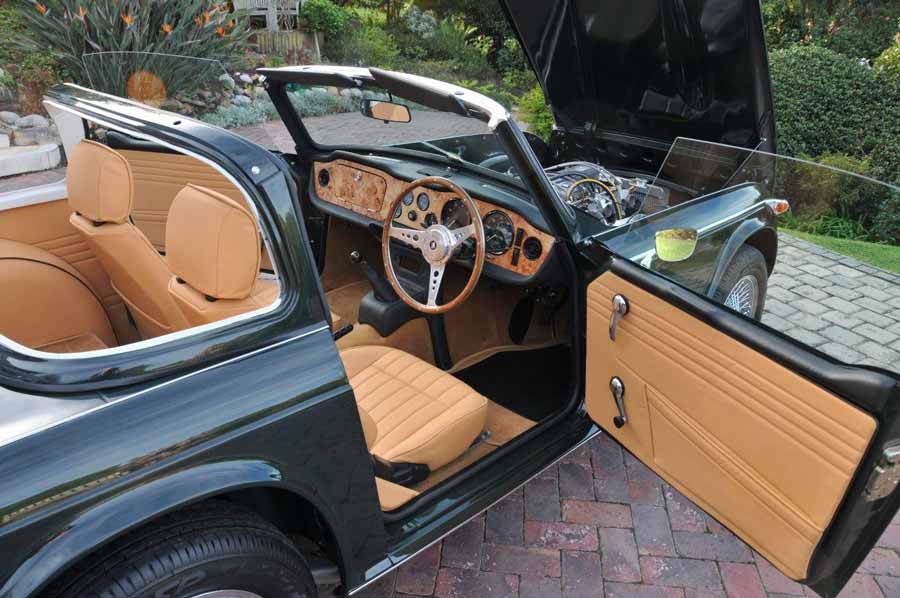
Loose upholstery trim
There were various pieces of upholstery to cover the bodywork of the car. These consisted of the Wheel Arch / Wheel-Well areas directly in between the Quarter Panels and Bulkhead Panel in addition to the B Post Pillar Covers and material to cover the Windscreen Frame.
Original materials
The TR4-TR250 models left the factory upholstered in a grained finish unsupported PVC material – often confused with Vynide (Leathercloth) which was used elsewhere in the cars. Commonly these days, this material is superseded with Vinyl (Ambla) due to availability and practicality of use for these areas. Very few cars, if any, would have left with Leather panels – and if they did, this would have been a special order item. At this point it is worth noting that when “Leather” is mentioned on the heritage certificates, this is often only referring to the Seats (more on this under the Seat Kits tab).
The Dash areas were remodelled by Michelotti for the TR4s, and then their design remained largely unchanged through to the TR6 era. The TR4 to TR6 models always left the factory with a black dash area, presumably as a cost-saving exercise alongside the undoubted acknowledgement that there is reduced glare from the sunlight on black surfaces, assisting in improved safety for the drivers. This Dash area consisted of the main Dash Top Panel, Lower Crashpads (left and right) and a Central Console H-Frame up-stand. All were supplied in an unsupported PVC material, vacuum formed around the frameworks. Unlike the TR4 and TR4A models before them, the TR5 / TR250 cars did not feature a grab handle on the Lower Crashpads. The Centre Console H Frame remained essentially the same as the TR4A version – but the Switch Plinth located above this Console was different – essentially inverting 180 degrees in terms of its basic appearance. These elements remained consistent for the most part until the end of the TR6 era of production with only minor and subtle changes being made in terms of the Steering Wheel Lock Mechanism, Air Vents on the Dash Top, and number of switch toggles on the Switch Plinth.
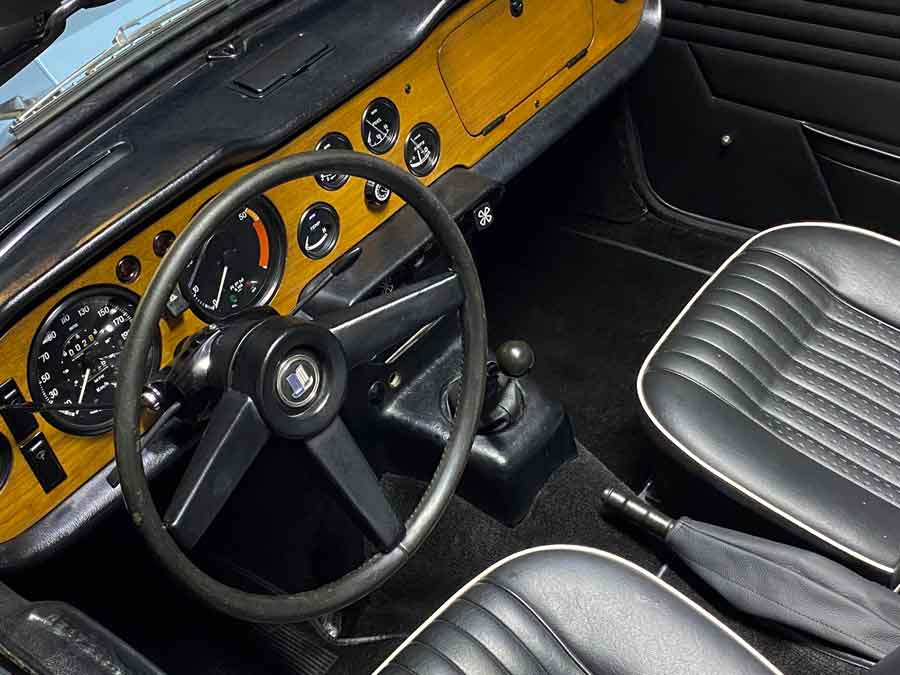
The Sunvisors also saw a change to the earlier TR4/4A style – with black becoming the colour of choice, made in an unsupported thin-PVC material – and a vanity mirror being introduced on the passenger side sunvisor. The fitment and fixings used to attach it to the car itself were also overhauled. Again, these changes remained consistent throughout the TR6 production run.
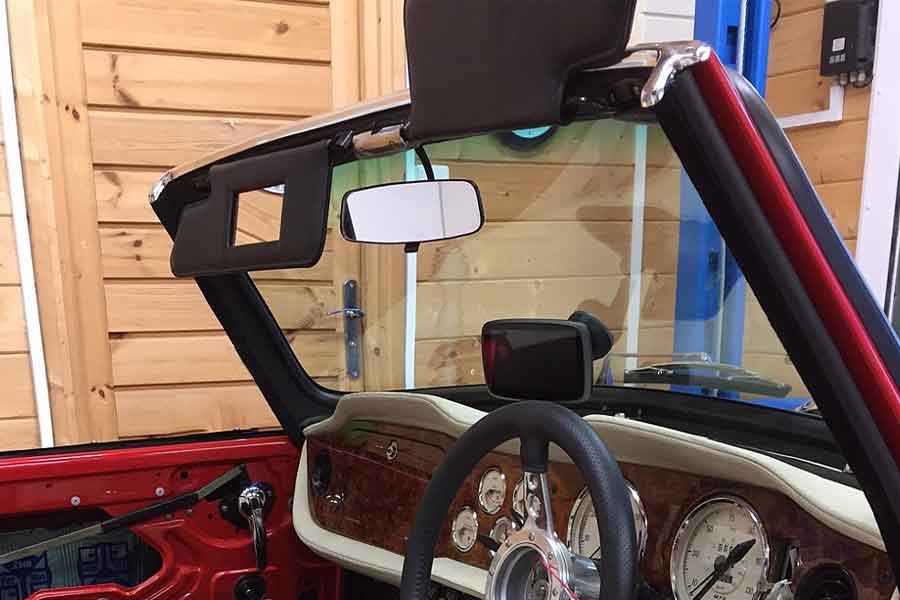
Piping
The TR5 & TR250 Door and Quarter Casing Panels continued to feature white piping/beading as per their TR4A predecessors – not only to improve aesthetics, but also to hide gaps between the panels and bodywork! There was no piping used to the Rear Bulkhead Panel, but the panel did feature an embossed nineteen-line vertical pattern running from top-to-bottom, as per the TR4/4A models. It should be noted that some archive reports suggest that the TR250 models seem to have left the factory with same colour piping as the main trim, not white as per most of the TRs of this era.
Seat Kits
Front Seats
Akin to the preceding models, the framework for the TR5 TR250 Front Seats was a tubular steel construction with a tilt (forward) mechanism, still with no allowance for reclining backward. As per the earlier TR4A models, there were mounted seat runners allowing for a forward/backward adjustment of the seat itself. The backrest squab framework differed significantly to the earlier TR4/4A models, with an interlocking wire framework attached to either side to form side bolsters. This in turn changed the construction of the backrest cover assembly which incorporated a 1″ (inch) horseshoe foam inside the cover itself to accommodate for these wire side bolsters. (At this stage it is worth noting that John Skinners are one of the only suppliers of the Seat Covers with this foam horseshoe already pre-inserted into the sewn Seat Cover). The horseshoe on the backrest continued to feature the ‘handed’ shape, allowing for the metal Hood Frame Cover to pass over without hitting the corners of the seat framework (the outside corners being more sharply shaped than the inside corners to form a more gentle curve). The same rubber diaphragms and backrest webbing strips were used as per the earlier models to act as lumber “springs,” and the foam padding kit was updated significantly to allow for the redesign of the frame and covers. It is worth noting that for these TR5 TR250 models, the backrest squab featured a soft upholstered rear cover, unlike the earlier models which used a trimmed hardboard panel.
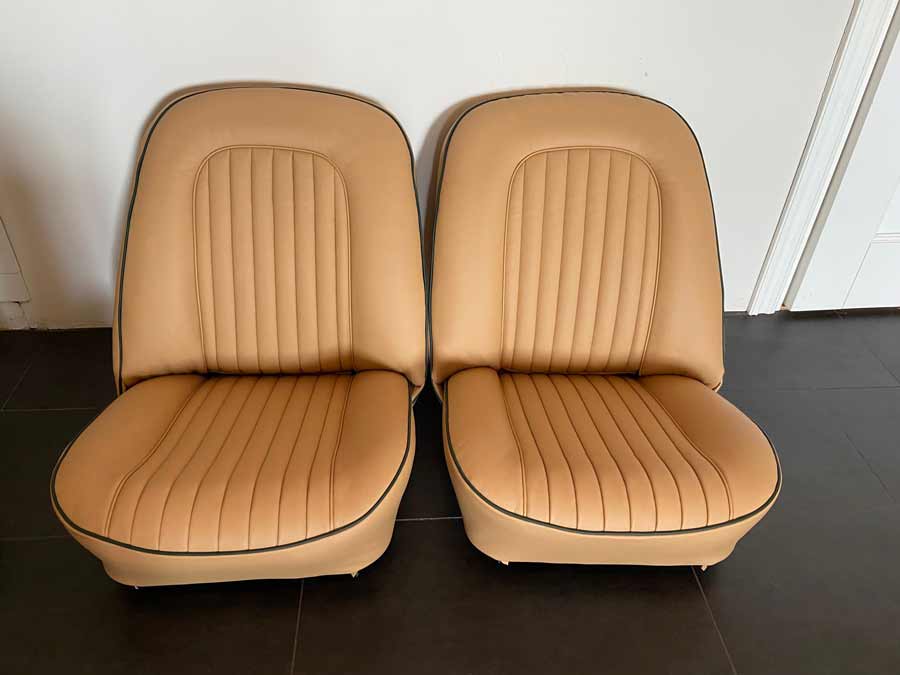
The TR5 TR250 models continued to use Vinyl (Ambla) for its seat materials, and Triumph embraced the radio/high frequency (RF/HF) technology used for some of the interior trim panels to add an embossed “diamond” pattern to their pleated seat panels. (It is worth noting that this pattern only covered about two-thirds of the pleated panel, ending toward the bottom of the backrest squab, and toward the very front bolster area of the cushion base; presumably due to limitations with the size/design of their brass tooling).
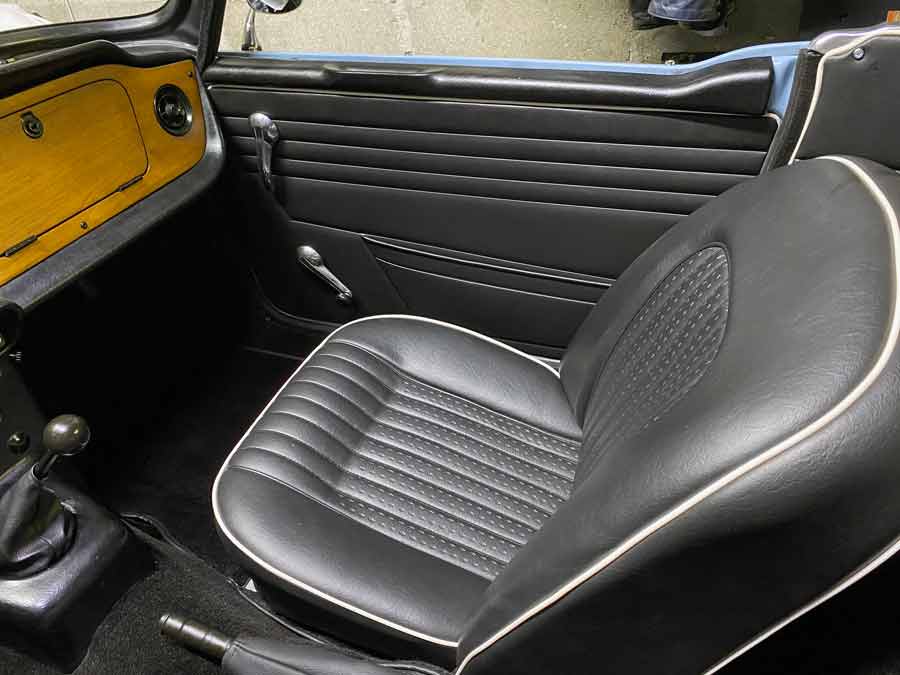
Some cars would have left the factory with Leather seat covers; albeit these would have most likely only been supplied with Leather to the facings of the seat (the elements of the seat covers which touch your body as you sit in the seat), with Vinyl used to the seat backs and surrounds. This configuration is commonly referred to as “LeatherFaced” and should not be confused with Full Leather. For all Leather/LeatherFaced seats – the pleats would have remained plain with no RF/HF embossing.
In keeping with the previous models – the Piping/Beading was originally supplied in White for the large majority of the cars that left the production line. This White piping would only be applicable to the “outside” sections of the Seats, with the inner horseshoe and side sections made in a matching colour to the main trim colour. Over the years, John Skinner has noted several original trim TR250 models and some TR5 models using same colour piping as the main trim throughout – and so, although not clearly documented – it is safe to assume that a number of cars left with this specification. This is especially noted for cars with Shadow Blue and Light Tan interior trims.
Seat hardware / fitment
As per the earlier TR4A cars – the Seat Frame was mostly made from tubular steel, and consequently the associated metal seat clips were used for the fitment process. The Paddings mostly consisted of moulded dunlop foam, with diaphragms and webbings being used as resistant mechanisms. However, as noted above, the TR5/TR250 Backrest “Squab” framework was quite unique with its “Wire-Wing” side bolster design – and thus the associated foam paddings were minimal as some of the foam elements were included as part of the actual Seat Cover Horseshoe design.
Rear Seats
The TR5 TR250 occasional Rear Seat reflected the design of the later style Front Seats; square in shape with HF/RF embossed lines running from back to front (akin to the Rear Bulkhead Panel) and finished with white piping to the outer edge. It was fitted on top of a plywood base, which was topped with a foam padding before the cover was trimmed over. A recess in the centre allowed for its positioning in the car over the Differential Hump. It was an optional extra for most cars, so whilst not commonly seen, it was present on enough cars to be worthy of a mention, and certainly adds a nice extra aesthetic touch to the rear of the car.
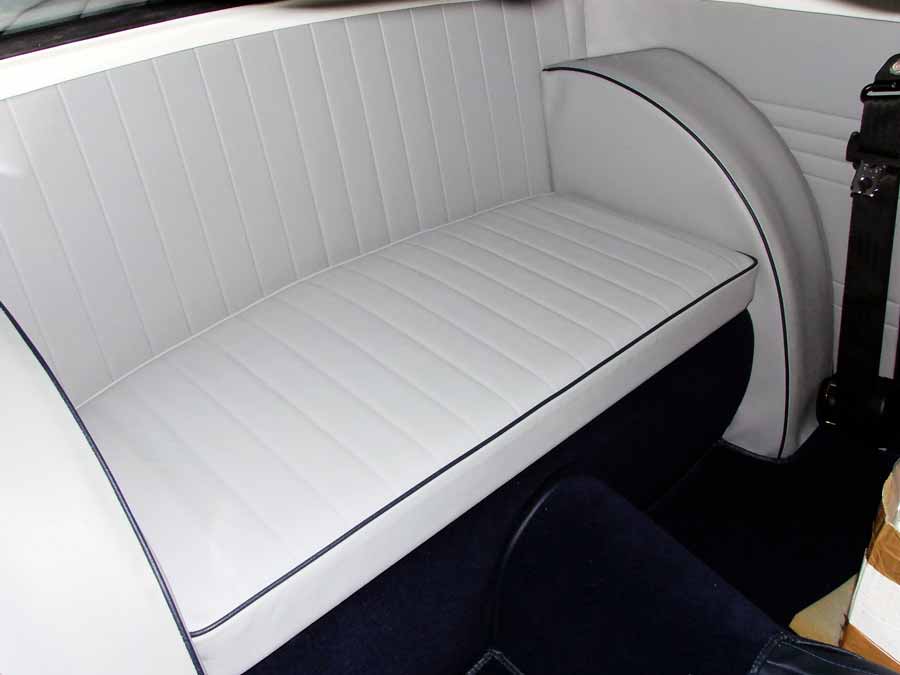
Carpets & Flooring
The Carpet Set for the TR5 TR250 was made to the same specification as the previous TR4A. The Front Floor Footwell Carpets extended up into the Engine Firewall Section of the car, underneath the Dash. The Rear Floor Carpets followed the curvature of the tub around the Wheel Arch Wheels. The Rear Shelf was a large one-piece setup which folded over the shelf and down onto the tub floor. There were cut-outs at the rear for the differential “diff” hump, and at the front for the Propshaft Tunnel. The Sills were carpeted, running from the A Posts to the B Posts along the base of the door opening step. The “A” Post Kick Panels in the footwell, positioned directly in front of the doors, were trimmed onto a millboard panel and affixed in the car. With the Gear Lever Stick being repositioned on the top of the H Frame Console Assembly, the carpet underneath this area allowed for the fitment of this floor-to-dash console framework. The Propshaft cover had a pre-sewn material Handbrake Gaitor Cover.

Original materials
For the TR4A, TR5 and TR250 models it appears that Triumph favoured using Wool “cut-pile” carpet, rather than the briefly used synthetic Nylon Rayon “loop-pile” carpet of the late TR3A and TR4 models. Some TR6 models seem to have also left with Wool carpets, before Triumph switched to a cut-pile Nylon synthetic material towards the end of the TR6 production era. The carpets were made in a colour to complement the main trim colour and featured a Vynide (Leathercloth) binding on the edges – and as with previous models, not all edges of every piece were bound. Exactly like the TR4A, there was a rubber ribbed Heel Pad situated on the Driver’s side Front Floor Footwell carpet, as well as a small “D” shaped Heel Pad on the Driver’s side vertical A Post Bulkhead Panel, and a matching “D” Heel Pad on the Driver’s side section of the Gearbox Clutch Housing Carpet.
Short note on Underfelt
Carpet Kits were fitted on top of a layer of Underfelt, providing basic heat and sound insulation with an additional layer of comfort underfoot. Typically this was a natural jute felt of around 6mm to 8mm in thickness. Not all the carpet sections were fitted with corresponding felts underneath them.
Fixings
Four different types of Fixings were used to keep the carpets in place and all these fixings are still available today.
Mounting Studs (A) are secured to the bodywork floor pans using Pop Rivets (B). Then the Pronged Rings (C) are pierced through the carpet pieces in various areas and secured using the corresponding chrome Carpet Clip (D) to the back of the carpet. This allows the Mounting Stud (A) and the Carpet Clip (D) to clip into one another thus securing the carpet parts in place. The positions of these fixings is a subject of much debate – although you should often be guided by the pilot holes found in the bodywork of the chassis itself.
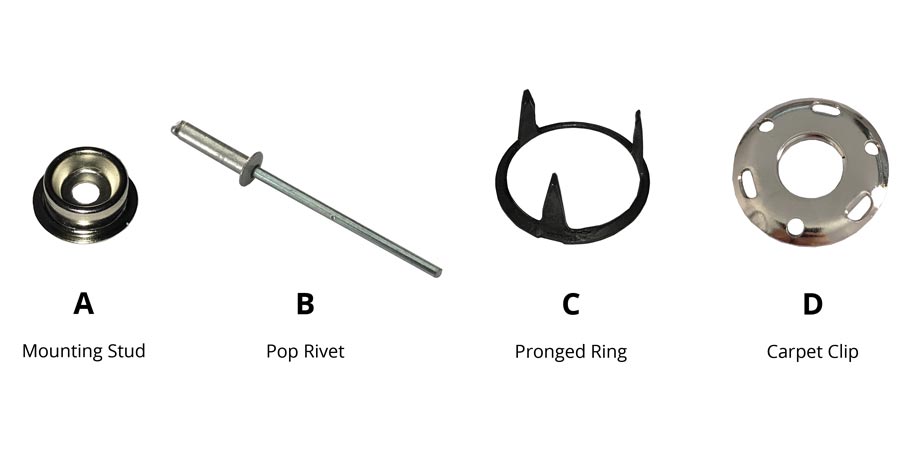
Boot / Trunk
The radical redesign of the Triumph TR4 chassis brought with it huge changes to the Boot Trunk area. As with the earlier TR2-3B models, the Boot Trunk area originally consisted of a Millboard Liner Panel that covered the bulkhead of the Boot Trunk area directly behind the main fuel tank. This was supplied as standard in a black surface grain finish to imitate the look of leather. This panel remained consistent for all the “Carb” TR4, TR4A (IRS) and TR250 models – but differed for the Petrol/Fuel Injected “P.I” systems of the short production run TR5 models. For the TR5 models, the panel was slightly wider with a creased element to the board allowing it to bend around and cover the fuel pump which was positioned in the left Wheel Arch Fender area.
Unlike the earlier models which came with a Boot Luggage Floor Mat fitted, the TR4 to TR5/250 models did not leave with any covering. The floor was fitted a black plywood base panel to cover the Spare Wheel, and it was only during the TR6 production run that a Luggage Mat was reintroduced into the cars. That being said, it has become common-place for restorers to lay a Boot Trunk Mat over this plywood panel.
The left and right side panels of the Boot Trunk Area were left exposed to show the painted bodywork. (It is worth noting here that John Skinner can supply Boot Trunk Side Covers for this area of the car which is often overlooked but can benefit from some extra attention in trimming). These are Millboard Panels – either supplied as standard in a black surface grain finish to imitate the look of leather, or covered in a material of your choosing (most commonly carpeted to correspond with the Boot Mat).
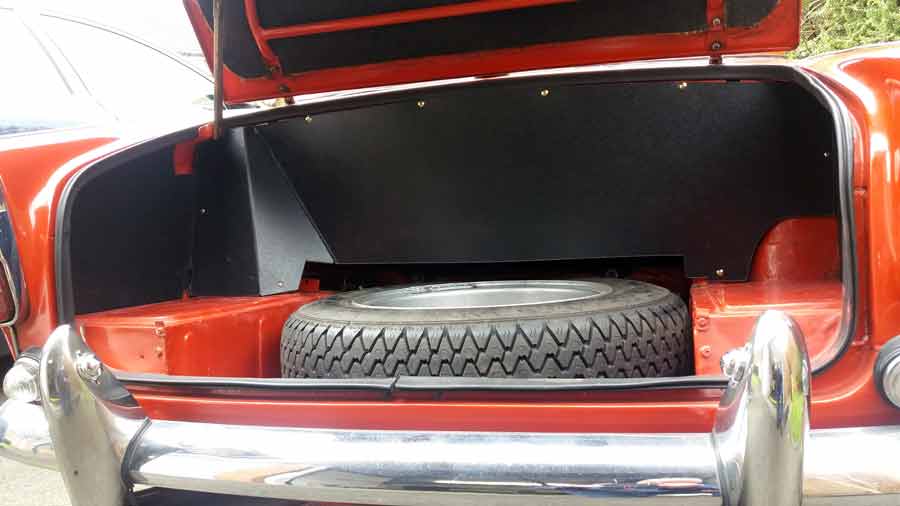
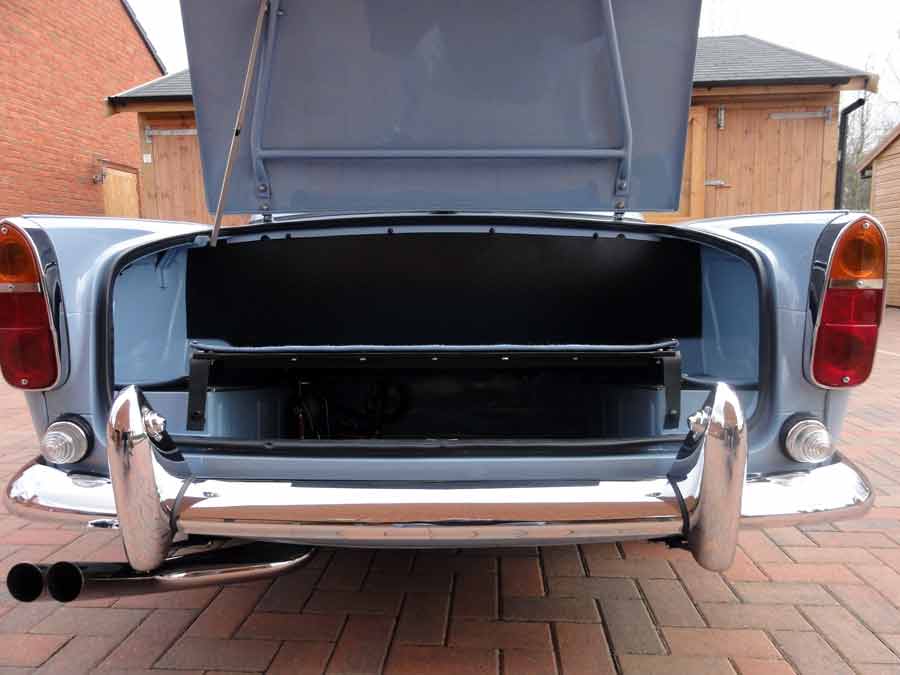
Weather Equipment
Convertible Soft Top Hood
The Triumph TR5 and TR250 models picked up where the TR4A had left off with the evolution of the Soft Top Convertible Hood. Again, visually very similar – there were some updates and improvements made – mainly focusing on the usability and fixing to the car during the erection and retraction process. The metal stick framework itself was revised at the area above the top of the door glass to allow for metal “U” channels to be included, containing rubber seals and velcro. The rubber seals were used to direct the flow of running water, whilst the velcro attached to the associated velcro on the material Hood. The front edge of the Hood was very similar to the TR4A version, with the excess unsewn edge material used to wrap around the header rail and the three-piece metal channel and rubber seal then being attached to the hood frame metalwork. However, the methodology for attaching this hood frame header rail to the windscreen frame was updated, with the clamps/toggles used on the TR4A cars replaced with two handle levers offering a more robust solution. Again, the rear edge of the Hood featured some excess material on the underside which was wrapped around a metal assembly bar which was then bolted to the rear deck bodywork of the car – but the fixings were updated with plastic press studs being used around the rear section for attaching the Hood Frame or Tonneau Cover. As with the earlier TR4 and TR4A models, the Soft Top Hood also included the 3 rear window set up which were HF/RF welded into position, and an additional left to right flap was sewn in the middle of the underside of the Soft Top with studs inserted which was used to wrap around the horizontal Hood Frame rod above the Driver’s head, and secure in place.
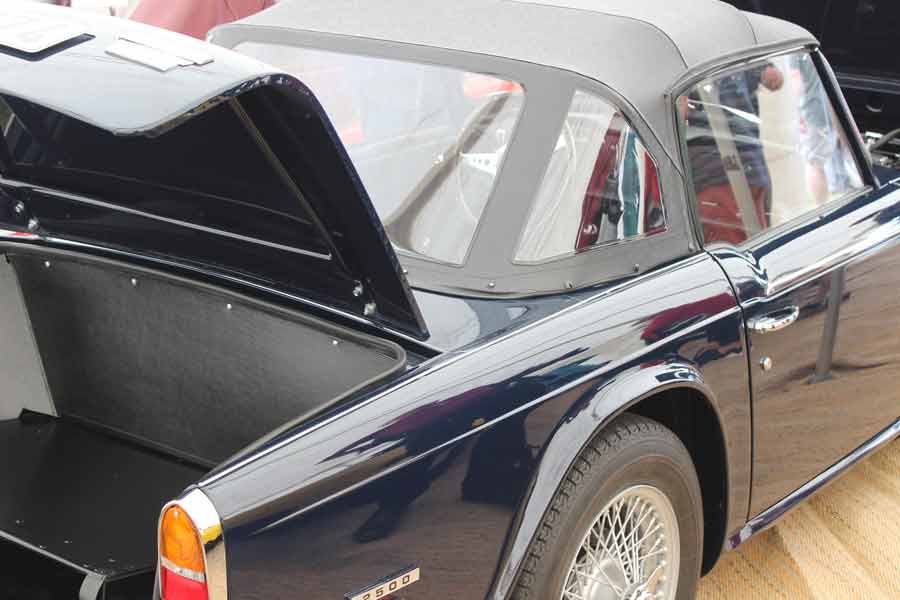
The majority of Triumph TRs left the factory with PVC Hooding – this is effectively a pvc vinyl plastic material with a waterproof membrane, and featuring a grain in the surface of the material to imitate vinyl/leather. The actual material used was Everflex (known as “British Everflex”) – which was an ICI trade name for PVC Hooding (think “sticky tape” and “sellotape”!). Some special-order models may have left with Deluxe Mohair Canvas (also referred to, albeit not exactly the same as Stayfast/Twilfast etc – see Glossary for more details). The clear plastic windows at the back were made in a Vybak plastic. The TR4 to TR6 Soft Tops all seem to have been available in either White, possibly Off-White, or Black Everflex from the factory production line. However, as mentioned previously, this is by no means set in stone – reports suggest that colours were also available for the Soft Top and Weather Equipment elements.
Records also suggest that some TR250 models featured a reflective silver strip around the outer and rear edges. This was only for the US/North American exported cars, to cater for changes to the road safety laws in the late 1960s. Certainly, all US exported TR6 models featured this finish, but it is not clear how many TR250 models would have included this additional strip.
Surrey Top Canopy
The TR4 models saw a “Surrey Top” version introduced as an option as standard from the factory production line. This incorporated a fixed window frame section at the rear of the car – similar to what you see on modern-day “Targa” cars – enabling the car to be semi-convertible with an opening directly above the driver and passenger seats, whilst maintaining the fixed and wind-shielding rear screen frame section. This half-hardtop version was offered as a standard factory option for all TR4, TR4A, TR5 and TR250 models; before being discontinued and replaced with an alternative full-hardtop style for some TR6 models. The Surrey Top models featured a removable Hardtop Panel that could be fixed in place to make the car essentially a full hardtop car. A soft material Surrey Top Canopy cover was also offered, allowing the owner to essentially use the car as an open-top car with an easy to fit (and much more transportable) cover for the Surrey Top opening should you get caught in a sudden downpour of rain!
The Surrey Top Canopy Cover was made in a very similar fashion to the Soft Top Convertible Hood in terms of the fixing method at the front of the Canopy and the side-gutter channels. The materials used and colours available matched that of the Soft Top options.
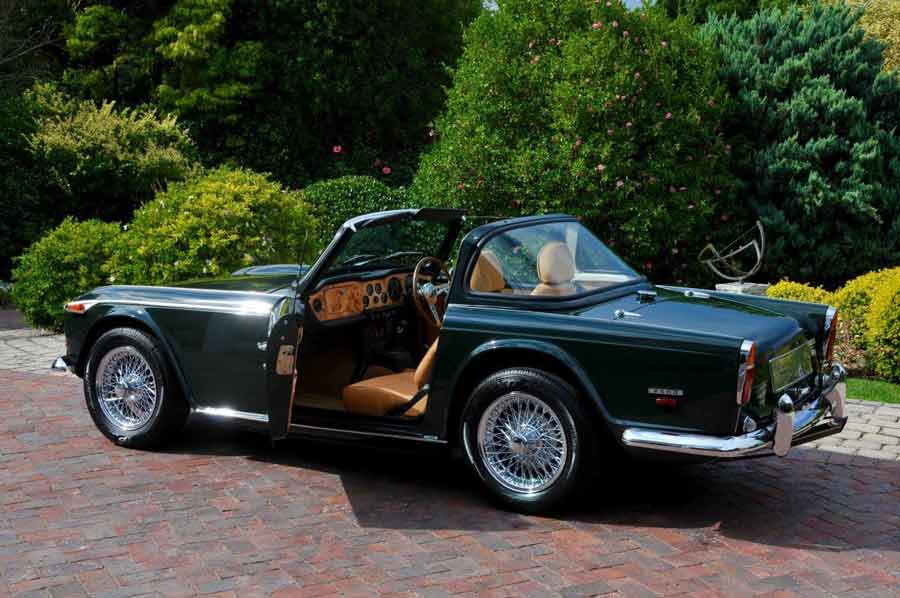
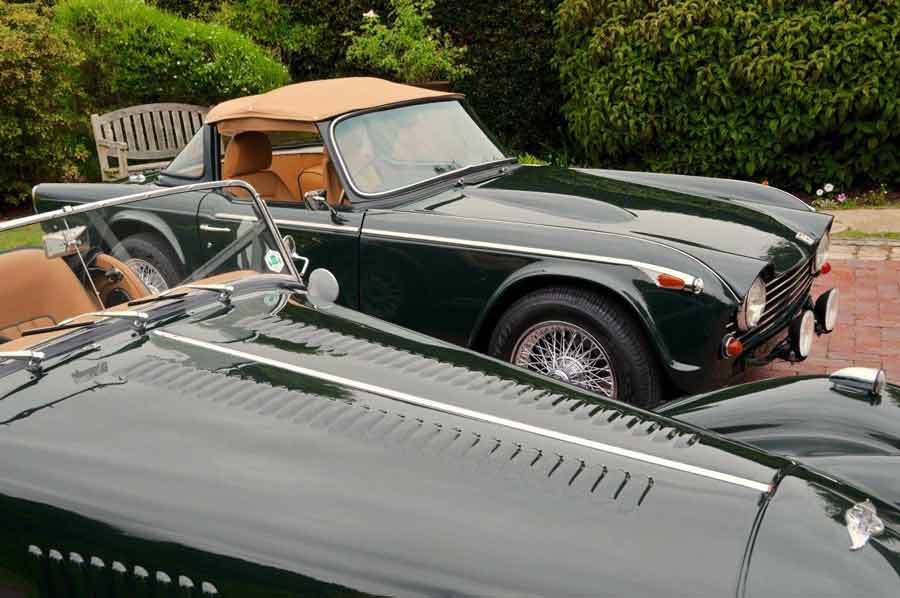
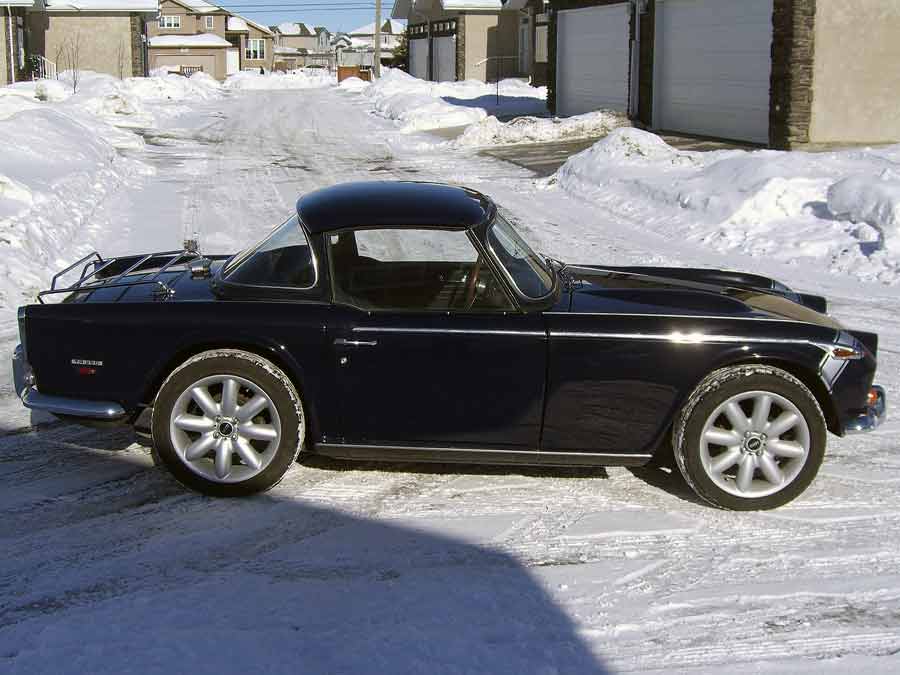
Hood Frame “Envelope” Cover
Triumph was one of the first sports car manufacturers to commonly use the Hood Frame Cover on their cars as a stowage cover for the framework of the convertible top. Sometimes referred to as “Hoodstick Covers” or “Top Frame Covers” or “Boot Envelope Covers” – this is the pre-sewn material cover that is used to hide away and cover up the folded down metal framework of the Soft Top Hood. On the early TR models, the Convertible Hood cover had to be removed from the frame prior to folding the frame away behind the seats and covering over using this Hood Frame Cover, or the briefly used Hood Frame 3pc folding Squab Unit of the TR4s.
For the TR4A models, the traditional Hood Frame Cover was reinstated, but with revisions to make it larger with the capability to accommodate the bulkier Hood and Hood Frame (as these now worked as one complete unit). Two horizontal rows of piping were featured, in a similar look and finish to the Seats and other interior trim panels. Small tabs were sewn to the underside of the front edges for fixings to attach to the Rear Bulkhead and B Post areas respectively. This design was maintained for all the TR4A, TR5 and TR250 models – with only changes to the fixings used to attach it to the bodywork being updated. They all used the “hood” press studs; with the TR4A versions supplied in silver, whereas the TR5/TR250/TR6 were originally in black (plastic).
Hood Frame Covers would have been made from PVC Hooding, and the colour would have always matched the colour of the Convertible Soft Top Hood and Tonneau covers when leaving the original factory production line.
It is worth noting that the Hood Frame Cover is only ever on show alongside the interior trim (and not any other Weather Equipment) and has no requirement to be waterproof. As a result, a popular option is to deviate from originality and have the Hood Frame Cover made from Vinyl / Leather to match the interior trim.
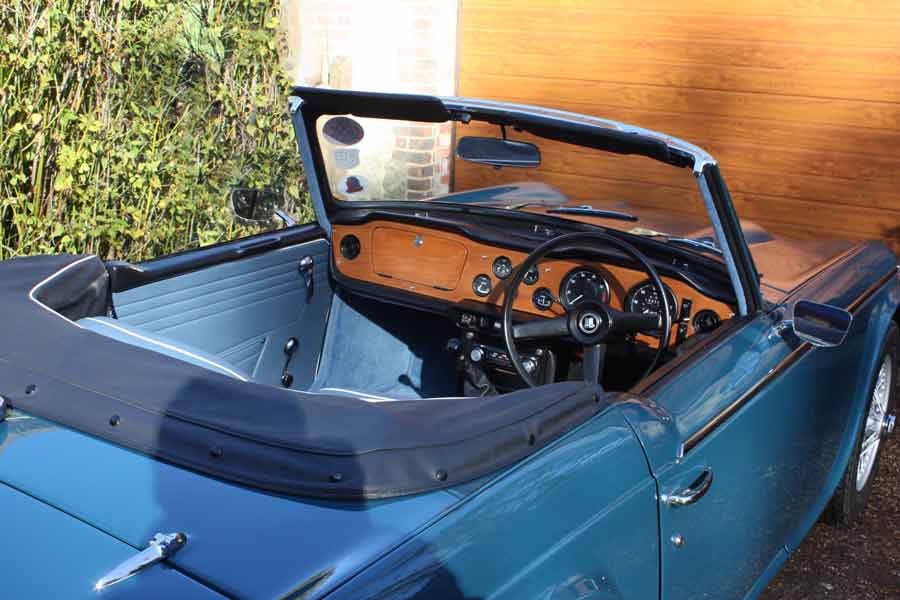
Tonneau Cover
Despite very obvious changes in the Tonneau Cover shape to suit the new TR4 chassis design, the overall concept of the Tonneau was the same as its predecessors with a pocket located on the Driver’s side to allow the steering wheel to be covered when the cover is fully in use and a slightly off-centre zipper offering a larger opening on the Driver’s side for when using the cover half-open. A tab was sewn to the underside of the Tonneau Cover for securing to the fixing located on the inside edge of the passenger side seat base framework. This design was maintained for the TR4A, TR5, TR250 and TR6 models that followed – with only changes to the fixings used to attach it to the bodywork being updated. The TR4 models used Lift-The-Dot fixings, whereas the TR4A, TR5, TR250 and TR6 cars used the “hood” press studs; the TR4A versions in silver, whereas the TR5/TR250 /TR6 were originally in black (plastic).
Headlining
For those cars fitted with the Surrey Top Hardtop Panel, both the Headliner Roof Assembly and Rear Screen Surrounds were originally upholstered in the same material – a heavy grained “longhorn” PVC material, in either a white-blue or black. This same material was also used to upholster the B Post Uprights and the Quarter Panel Tonneau Cappings making up the Rear Screen Surround.
The main headlining section of the Surrey Top was a pre-sewn cover with scrim loops sewn onto the underside which was used to insert three metal rods that went from left-to-right in the car to secure the headliner in place.
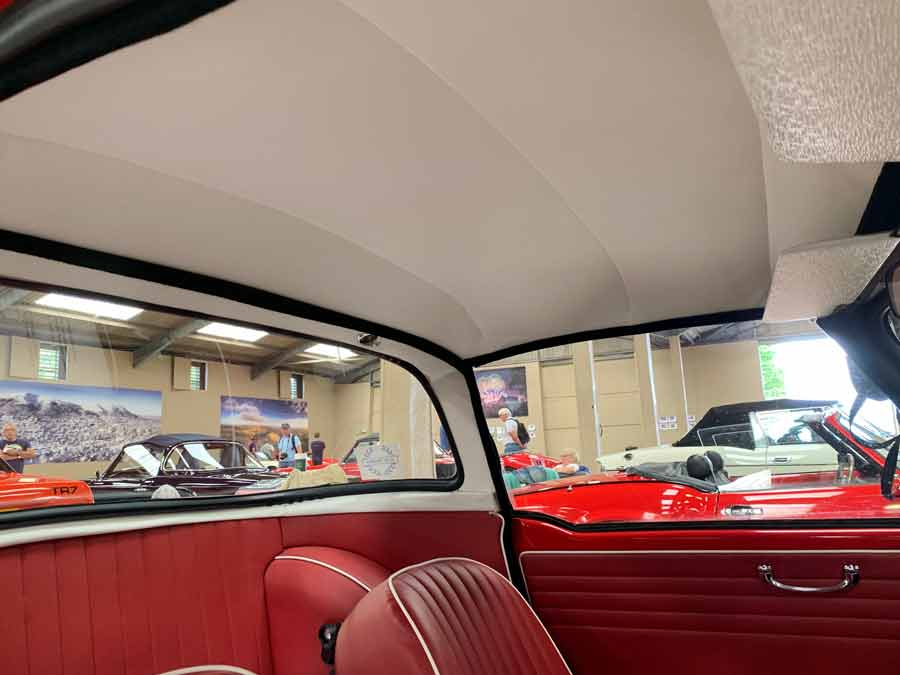
Glossary of Materials
Armacord – a coloured grained PVC material with a natural jute felt backing and ribbed surface finish. Very similar to Hardura in quality but the ribbed effect was a finish used specifically to Austin Healey models across a combination of Rear Floor, Boot Trunk and Rear Deck areas depending on the model specification. Also seen on Jaguar C Type Gearbox Tunnels.
Beading – see ‘Piping.’
Binding / Edging – a strip of Leathercloth that is fed through a binding machine and secured around the edge of a carpet. Generally only applied to edges of carpets that are exposed when fitted. Leathercloth is a sturdy yet nimble material that gives a neat and durable edge to carpets, enabling them to lay flat when fitted. (Please note, Vinyl binding – although available in a wider colour choice – is thicker than Leathercloth which results in a bulky appearance. It can also catch and snag easily, and wrinkles around corners when sewing. For these reasons, we never use Vinyl to bind our carpet edges at John Skinners).
Carpet: Karvel – Karvel carpet is a utilitarian floor covering with a tough ribbed surface structure and a woven hessian backing. Seen most commonly throughout Austin Healey and MGA interiors.
Carpet: Nylon – Nylon carpet is a man-made material constructed from polypropylene fibres glued to a flexible rubber backing. Ideal for budget restorations, or for areas of the car that are rarely on show e.g. Boot / Trunk areas. Avoid this choice for the main cockpit cabins if possible – Wool is always preferable and far superior.
Carpet: Wool – Wool carpet is spun from wool yarn and glued to a flexible rubber backing. The wool fibres provide a thick, springy and dense pile that doesn’t spread when fitted over bodywork curvature. Luxurious to the touch. Something about superior in quality, finish/touch etc etc – this should be the choice for most restorations
Carpet: Wilton Wool – used for immensely luxurious, spacious and often chauffeur-driven saloon cars e.g. Rolls Royce and Bentley. Very densely packed, fluffy pile – akin to living room carpets. Not suitable for sports cars where its quality and feel looks out of place.
Carpet: Loop Pile – a carpet where fibres are ‘looped’ and left uncut to create a flat and durable carpet surface. Most commonly used on Triumph TR4s. Please note that Loop Pile carpet is not supplied by John Skinners.
Edging – see ‘Binding.’
Fibreboard – see ‘Millboard.’
Furflex (Tac-On & Snap-On) – with a similar velvet-like touch to Moquette, Furflex is the name given to a very short pile, high quality wool mix material wrapped around a rubber tube with a flanged edge. Used most commonly for trimming around door edges for the purposes of a draught excluder.
Hardboard – a versatile wood based material with one side having a very smooth finish and the other a heavily grained finish. It was used very extensively for Trim Panels and gradually replaced Millboard. ‘Motor Grade’ Hardboard is around 2.5mm thick – thinner than the more readily available 3.00mm – that 0.5mm makes all the difference – which allows for doors to close fully against draught excluders and be fitted to the bodywork of the car with the use of Trim Clips which are designed specifically for use with the original 2.5mm thick board.
Hardura – a coloured grained PVC material with a natural jute felt backing. Most commonly used to trim Boot Trunk areas – particularly across the Jaguar range – and was also used for flooring and other interior parts.
Headlining: Union Cloth – a woven material made from wool/other fibre mix (around 80% wool content, 20% cotton). Ideal for lining the interior roof of the car – most commonly Jaguar XK and MK2 (Saloon) models. Available in 2 colours; beige and grey to complement all interior colours. 200cm wide.
Headlining: “West of England” Wool Cloth – a woven material made from 100% wool fibres ideal for lining the interior roof of the car – most commonly Jaguar Saloon, Sedan and XK-E models. Available in 3 colours; beige, green and grey to complement all interior colours. If trimming a roof from its bare bodywork, opt for pre-bonded foam backed wool cloth to avoid having to twice glue and trim the headlining area; first to apply a foam base, then to glue and trim the headlining onto the foam. 150cm wide.
Hidem – made from Leathercloth or Hooding, Hidem is a type of banding – around 16mm wide – with a central seam running through it that can be used to hide unsightly tacks and staples across trimming work. Seen, for example, around the base of the backrest on Austin Healey BN1-BN4 Front Seats; and commonly seen on the header rails of soft top convertible Hoods.
Hooding: Deluxe Mohair Canvas – a woven twill waterproof canvas material with a dense rubber membrane encased between its twill surface and a textured dobby backing. A premium material seen most commonly on Soft Top Convertible Hoods for the Jaguar XK and some E-Type models. With minimal shrinkage qualities, Deluxe Mohair Canvas is exceptionally durable. Can also be referred to / known as – DMC, Canvas, Haartz®, Sonnenland®,, German Canvas or Dobby Cloth.
DMC is the superior canvas hooding product; more so than the commonly seen SMC (Standard Mohair Canvas) products on the market, which can also be referred to / known as – Stayfast®, Twillfast®.
Hooding: PVC – a waterproof plastic coated material with a knitted cotton backing. Heavily grained surface finish. ‘Everflex’ is the ICI trade name for PVC hooding. Can also be referred to as – British Everflex, Vinyl Hooding or Crush Grain Vinyl.
Leather – a natural product derived from animal skins with marks, blemishes and scratches an inherent part of the materials’ surface and character. Modern day processes – such as mechanical graining and dyeing techniques – help hide imperfections to maximise use of the hide, reduce production waste and make leather products accessible to the wider market. Whilst Vaumol™ natural grain leather would have been original for these cars, our Grained, Smooth and Antiqued Leathers offer a more than suitable alternative in keeping with originality – you can read more about these here.
Leathercloth / Vynide – both names refer to the same material; a coloured and lightly grained PVC material with a thin woven cotton backing and no stretch. Leathercloth / Vynide replaced Rexine in the marketplace. ‘Vynide’ was the ICI trade name for this material. Used for Trim Panels, Piping & Binding. The choice for restorers looking to return their interior to truly original specification. Available in a select range of colours.
Millboard – a flexible and tough cardboard like material with a grained finish to its surface. Used for Trim Panels & Boot Trunk Areas. Can be creased to allow for bending around bodywork fixtures such as Petrol Filler Pipes. Can also be referred to as ‘Fibreboard.’
Moquette – a short pile, high quality wool mix material with a velvet-like touch. Used for various trim items across the Jaguar range such as Seat Backs, Wheel Arch Covers and Trim Panels. Available in a variety of colours.
Piping – a flexible core encased in either Leathercloth or Vinyl and finished with a flanged edge. Sewn around seat edges and pleated panels, and either sewn or stapled to some interior panels such as Wheel Arch Covers or Door Panels. (Please note, although Vinyl piping available in a wider colour choice than its Leathercloth counterpart, it is thicker than Leathercloth which results in a bulkier appearance. It can also catch and snag easily, and wrinkles around corners when sewing. We would always recommend to use Leathercloth piping where possible, unless you feel particularly limited by colour choice within the Leathercloth range).
Piping: Chrome (as seen on Austin Healey BJ8 Front & Rear Seats) – a silver and black twisted yarn core encased in bendy plastic with a flanged edge to create a ‘chrome’ / metallic effect piping. Original for Austin Healey BJ8 Vinyl Front & Rear Seats. Often referred to incorrectly as ‘gold’ piping (the result of the original chrome piping yellowing through age and sunlight exposure).
Piping: Plastic (as seen on Triumph TR4-TR6 Panels & Seats) – a 3mm moulded plastic piping only available in Black or White. Originally used for Triumph TR4-TR6 Interior Panels & Seat Kits. No longer used by John Skinner for Seat Kits as it does not provide the flexibility required for good seat structure. John Skinner would only use this plastic piping on trimmed panels if customers are not ordering seats to match. Where customers are ordering both Interior Panels & a Seat Kit, Leathercloth piping is used in place of the original plastic piping.
Rexine – a coloured and lightly grained plastic material with a thin woven cotton backing and no stretch. Rexine was an early type of Leathercloth, but thinner and of a similar quality to book-binding material. Used across Trim Panels, Piping & Binding. It is no longer available on the market and was gradually superseded by Leathercloth / Vynide.
Underfelt – a natural material made from compressed jute felt fibres to offer heat and sound resistance properties. Anti-scuff finish to face. Flexible, durable and essential for flooring restorations to ensure carpet kits fit correctly. Place directly onto the bodywork floor of the car prior to fitting carpets on top. Can be used in conjunction with modern-day heat and soundproofing materials such as Dynamat®.
Vaumol™ – a leather finishing process developed in-house by Connolly Leather to celebrate the natural and individual characteristics, patina and aroma of each hide. The leather is vegetable tanned and surfaced dyed and left with its natural grain to the surface which is enhanced through the Vaumol™ finish. ‘Luxan’ hides are further enhanced with a secondary colour application.
Vinyl / Ambla – both names refer to the same material; a coloured grained PVC with a thick knitted cotton backing allowing for good stretch qualities. Its knitted backing makes it thicker than Leathercloth / Vynide. ‘Ambla’ was the ICI trade name for this material. It was introduced to the market in the early 1960’s and was used widely across Trim Panels & Seats from this period onwards, quickly replacing its Leathercloth alternative. Favoured by today’s restorers due to its more flexible nature and wider colour range availability, it is quite common to see Vinyl used as a substitute for Leathercloth.
(Note that for carpet edging and seat piping, we would always recommend using Leathercloth. It is thinner than Vinyl, making it more suitable for sewing round corners and curves without wrinkling or adding bulk).
Our Customers' Cars
…and people say that “pre-manufactured upholstery kits will never fit“.
Our customers beg to differ; and we have the photos to prove it – thanks to thousands of loyal clients from all over the world keeping us informed about their restorations.
See for yourself…and remember – it is our accurate pattern making (all from original templates & donor cars) and in-depth knowledge of these cars, as well as our precise, modern-day manufacturing processes that enable us to produce world class, award winning kits rarely rivalled by others.
Whether you’re a professional trimmer or an amateur enthusiast – a John Skinner Ltd kit is the best way to kick-start your interior trim restoration.
From our Handbook
Start building your Quotation
Build-a-Quote
Use Build-a-Quote to create your own quotation, specific to your car & restoration requirements.
Unsure on what parts and colours you need? Add all the options you’re considering and we’ll be back in touch to discuss further. For more information on our Build-a-Quote system, please see our FAQs.







